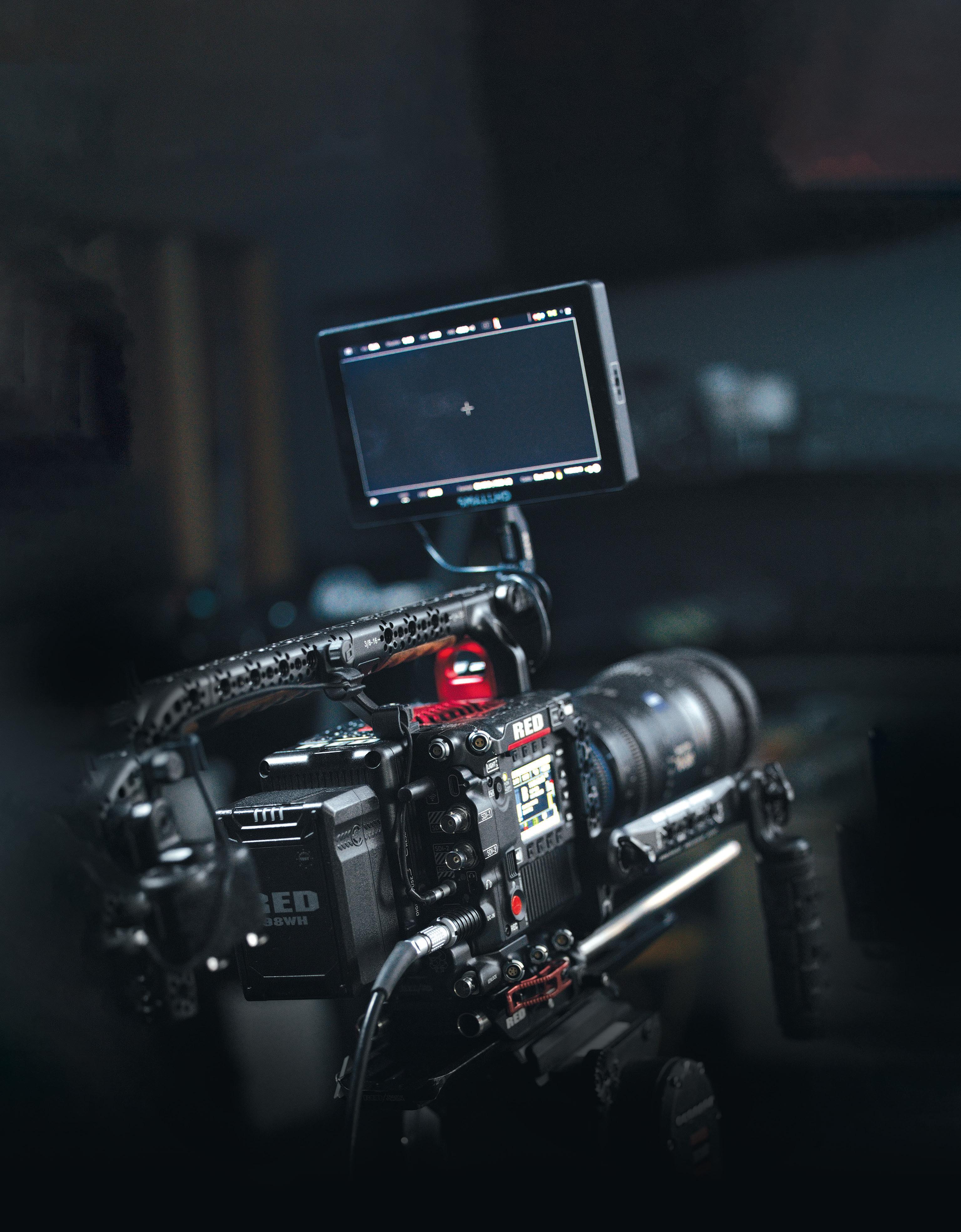




MENA OTT stakeholders refine content and technical strategies to boost subscriptions
Managing Director Raz Islam raz.islam@cpitrademedia.com
+971 (0) 4 375 5471
Managing Partner Vijaya Cherian vijaya.cherian@cpitrademedia.com
+971 (0) 55 105 3787
Director of Finance & Business Operations
Shiyas Kareem shiyas.kareem@cpitrademedia.com
+971 (0) 4 375 5474
Editor Vijaya Cherian vijaya.cherian@cpitrademedia.com
+971 (0) 55 105 3787
Sub Editor Aelred Doyle
Group Sales Director Sandip Virk sandip.virk@cpitrademedia.com
+971 (0) 50 929 1845 / +44 (0) 7516 993 862
Art Director Simon Cobon simon.cobon@cpitrademedia.com
Designer Percival Manalaysay percival.manalaysay@cpitrademedia.com
Photographer Maksym Poriechkin maksym.poriechkin@cpitrademedia.com
Data & Production Manager
Phinson Mathew George phinson.george@cpitrademedia.com
Web Developer Abdul Baeis abdul.baeis@cpitrademedia.com
Web Developer Umair Khan umair.khan@cpitrademedia.com
Dominic De Sousa (1959-2015)
Published by
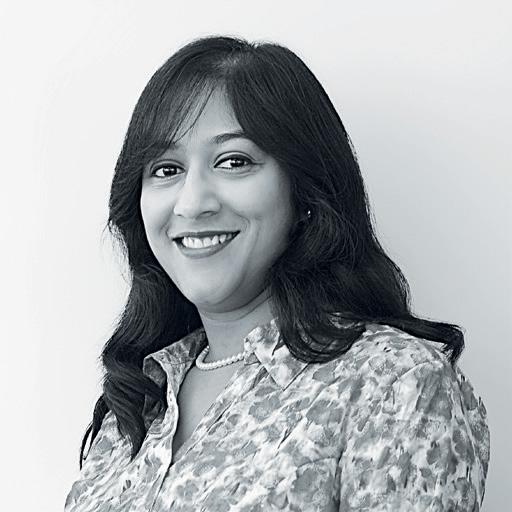
The MENA OTT video market is estimated to be worth $4.79bn this year, according to Statista. The annual growth rate (CAGR 2024-2029) is anticipated to be 6.13%, leading to a projected market volume of $6.45bn by 2029.
With so much money on the cards and a vastly demanding, content-hungry audience that harbours no loyalties to any platform, streamers are continuously having to innovate to ensure minimal subscriber churn. In the roundtables BroadcastPro ME has hosted this year, personalisation strategies have been at the core of the discussion. This edition features two of those roundtables, both entailing participants discussing how they try to retain subscribers on their platforms. We brought together a mix of streaming platforms, including general entertainment, sports and e-commerce players.
In the course of our discussion, super apps were mentioned as a potential way forward by some. Others remarked that the addition of sports helps a platform draw in new subscribers. Once they are in, platforms then try multiple means to retain them. In the case of an e-commerce platform like Noon, it has entered the sports fray to offer an integrated e-commerce and entertainment experience, hoping to leverage its strength in the former to bulk up the latter.
Streamers have several challenges to contend with in the current market and are constantly revisiting their content and technical strategies to address them. In fact, AI has helped anticipate when a subscriber is about to leave, and has been empowered to then offer that viewer an incentive to remain on the platform. The roundtables have served as great areas to learn about the day-to-day challenges in the industry and how they are being tackled. We have shared all those invaluable insights with you in this month’s edition. Happy reading.

VIJAYA CHERIAN, EDITORIAL DIRECTOR






ASBU, Arabsat and Globecast renew and extend GAB partnership; Deltatre hires Wajdi Maalouf; Deep Dive Dubai partners with Advanced Media to upgrade cameras; 94.3 Royal FM Kigali opens studio with Lawo solutions; Greek broadcaster deploys Riedel’s Simplylive Production Suite; and more


In the relentless pursuit of profitability, OTT platforms contend for larger subscriber bases, lesser churn, better efficiency through automated processes and hyper-monetisation modules. Industry veterans discuss how to build a lucrative OTT landscape 24
With sports dominating the entertainment landscape and viewer demand for diverse formats surging, some of the market’s top contenders gathered at a BroadcastPro ME roundtable to explore the dramatic changes in sports consumption and what spread to offer a sports-hungry audience
With a surge in the uptake of FAST channels, personalisation strategies, targeted advertising and audience segmentation are some of the key factors to help boost viewer engagement and monetisation, say experts


The Arab world is seeing an unprecedented rise in local productions, especially with the opening up of KSA’s media landscape. Content stakeholders at a BroadcastPro panel discussed leveraging local narratives, investing in film infrastructure, nurturing talent and achieving success with hyperlocal stories
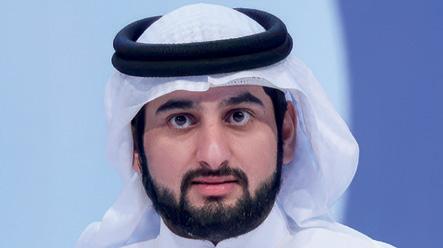
FILM
Dubai Media Council opens scholarship registration for Emirati media students

SATELLITE
EnduroSat and BIUST partner to develop Botswana’s first satellite

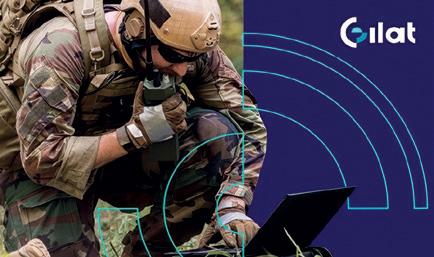
SATELLITE
Gilat secures over $9m in orders to support US

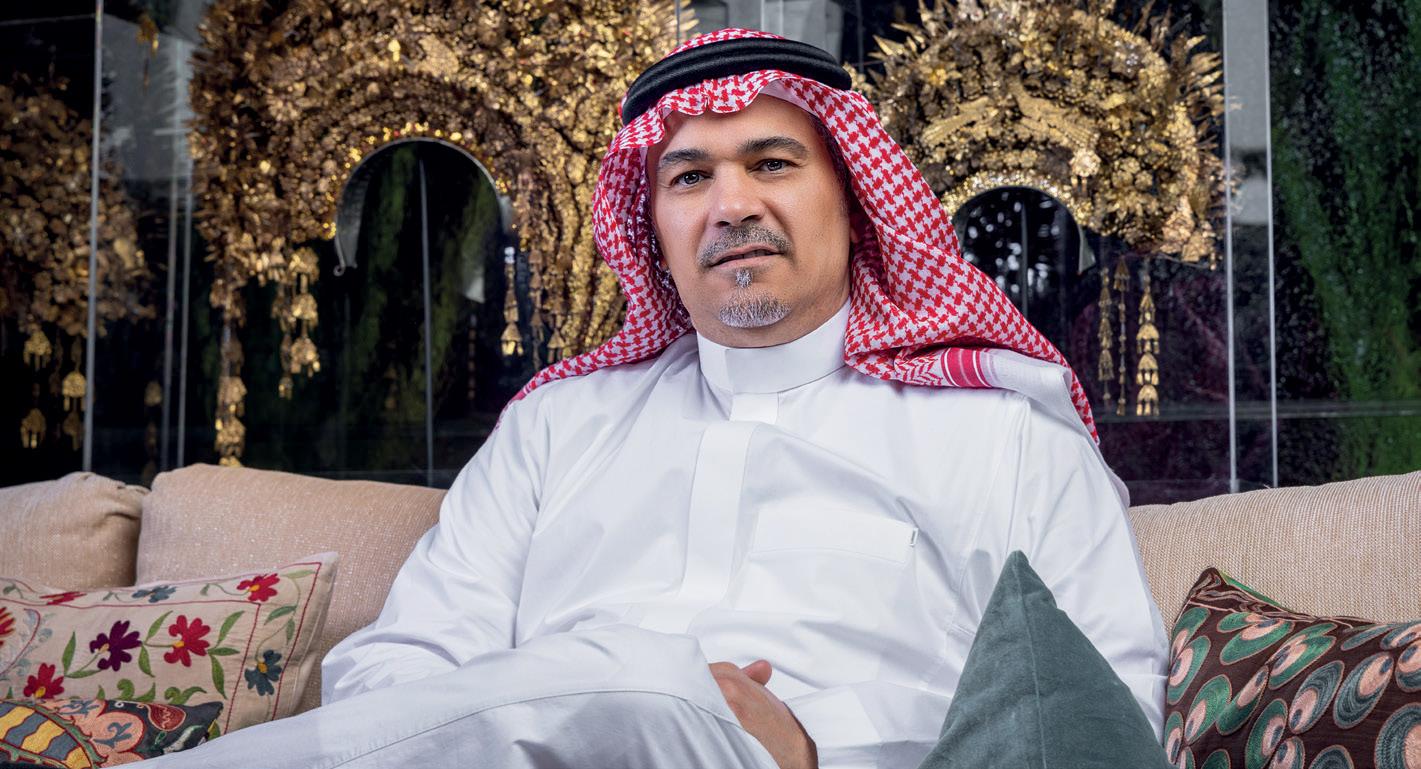
INTERVIEW: RMS CEO advocates transparency through metrics


Let’s create a vibrant online broadcast community!



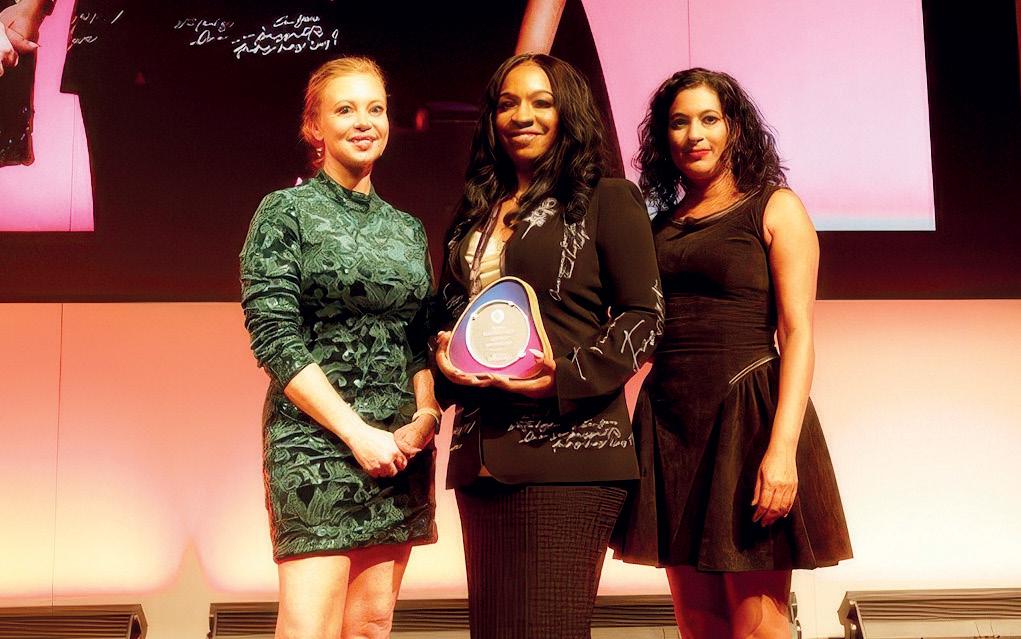

PRODUCTS
Ikegami to introduce HDK-X500 HD portable camera system at IBC
The HDK-X500 incorporates the latest-generation AXII digital processor which delivers high reliability, lower power consumption and enhanced functions
NEWS
IBC unveils features to enhance networking, learning and business opportunities
Exhibitor space for IBC2024 has surpassed 45,000sqm, with more than 1,100 exhibitors signing contracts to date
NEWS
IBC opens registration for 2024 edition
BBC Studios, beIN Media Group, Fremantle, Paramount Global and Virgin Media O2 to feature speakers at IBC Conference

CINEMA
Vox Cinemas partners with beIN Sports to screen Formula 1 races

FILM
Egyptian thriller Smokey Eyes set for Jordanian debut at Amman Int’l Film Festival

TV
Fatafeat to premiere Kitchen Tales: Summer Edition on July 8
NEWS
IBC calls for nominations for 2024 Innovation Awards
The winners will be announced at a ceremony on September 15

ESPORTS
TikTok becomes official entertainment platform for Esports World Cup
NEWS
IBC 2024 opens call for Technical Papers submission
The Technical Papers programme will accept entries from all sectors across the media, entertainment and technology industry
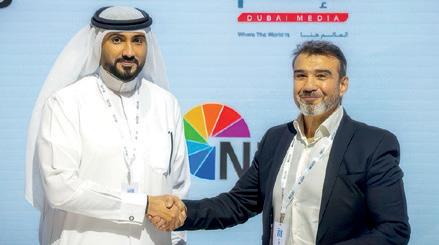
OTT
Dubai Media and NEP Group sign MoU to exchange expertise in media services
07/24
Global Arabic Bouquet Television (GAB) has extended its partnership with the Arab States Broadcasting Union (ASBU), Arabsat and Globecast to further enhance the reach of Arab public broadcasters. The announcement was made at the Arab Radio and Television Festival in Tunis last month.

The deal will see Globecast enhance its services for GAB by adding terrestrial distribution to its existing IPTV, digital TV and OTT platforms. Viewers can access GAB via Sling, Freeview, a custom application for Roku
and operators across the US, Latin America, the UK and France. Launched in 2004, GAB combines a range of
Arabic public broadcasters, including Saudi Broadcasting Authority, Sharjah TV, Oman TV and Kuwait TV, into a single package distributed worldwide via satellite, OTT and now terrestrial platforms. For the past 20 years Globecast has been the preferred solutions partner for global satellite distribution, managing GAB’s distribution from its technical facilities across the US, Europe, Africa and Asia.
London-based visual entertainment tech services company DNEG Group has received a $200m investment from United Al Saqer Group (UASG), an Abu Dhabibased investor, at a total enterprise valuation exceeding $2bn. With a 25-year history in VFX, DNEG Group will use the investment to accelerate its strategy of innovation and diversification. This will enable the company to make the transition from a pure
VFX services provider to a sector-agnostic content production and AI-powered technology partner, maintaining its leadership in technology and creativity.

DNEG Group will fully activate its technology division, Brahma, which is developing AI-powered, photo-real CGI creators including Ziva, for which DNEG recently acquired the exclusive licence from Unity. Brahma aims to democratise photo-real content creation across various applications. The company’s IP and content creation arm, Prime Focus Studios, will expand its investment in and production of high-
quality content, following its recent successful co-production of The Garfield Movie.
DNEG will open a new office and visual experience hub in Abu Dhabi, with plans to develop a world-class ecosystem in the Middle East for content production, storage and distribution. This will also support the creation of highly skilled jobs across the region’s media and technology sectors.
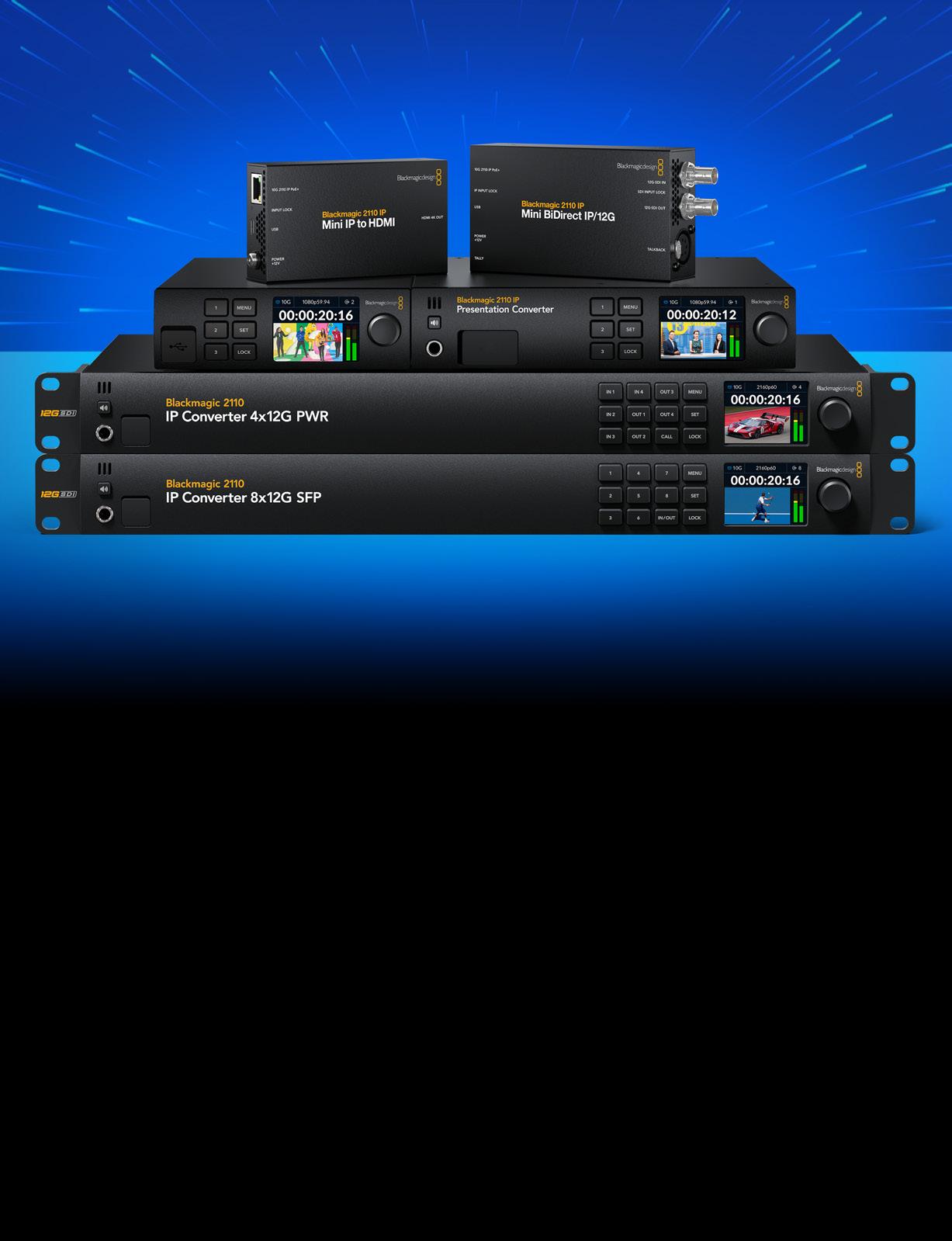

Now you can build affordable live production and broadcast systems with SMPTE-2110 video! Blackmagic Design has a wide range of 2110 IP products, including converters, video monitors, audio monitors and even cameras! You get the perfect solution for intergating SDI and IP based systems. Plus all models conform to the SMPTE ST-2110 standard, including PTP clocks and even NMOS support for routing.
The Blackmagic 2110 IP Converters have been designed to integrate SDI equipment into 2110 IP broadcast systems. The rack mount models can be installed in equipment racks right next to the equipment you’re converting. Simply add a Blackmagic 2110 IP Converter to live production switchers, disk recorders, streaming processors, cameras, TVs and more.
Conforms to the SMPTE-2110
Blackmagic 2110 IP products conform to the SMPTE ST-2110 standard for IP video, which specifies the transport, synchronization and description of 10 bit video, audio and ancillary data over managed IP networks for broadcast. Blackmagic 2110 IP products support SMPTE-2110-20 video, SMPTE-2110-21 traffic shaping/ timing, SMPTE-2110-30 audio and SMPTE-2110-40 for ancillary data.
Blackmagic 2110 IP Converters are available in models with RJ-45 connectors for simple Cat6 copper cables or SFP sockets for optical fiber modules and cables. Using simple Cat6 copper cables means you can build SMPTE-2110 systems at a dramatically lower cost. Plus copper cables can remote power devices such as converters and cameras. There are also models for optical fiber Ethernet.
One of the biggest problems with SMPTE-2110 is needing an IT tech on standby to keep video systems running. Blackmagic 2110 IP converters solve this problem because they can connect point to point, so you don’t need to use a complex Ethernet switch if you don’t want to. That means you get the advantage of SMPTE2110 IP video with simple Ethernet cables, remote power and bidirectional video.
View Master Events, a production company based in Athens, has used Riedel Communications’ solutions to enhance the quality of cultural, educational and sports events at the Stavros Niarchos Foundation Cultural Centre (SNFCC). Drawing on its extensive experience in film and event production, View Master Events has partnered with Live Productions to create a UHD5 OB van.
In collaboration with Telmaco, a European systems integrator based in Athens, the UHD5 has been outfitted

with advanced technologies, including Riedel’s MicroN UHD, Artist-1024, SmartPanel and Bolero solutions. These ensure seamless connectivity with SNFCC’s technical infrastructure through MediorNet Compact stage
boxes, enabling smooth production processes at one of Athens’ most iconic venues. Since its opening in 2016, the SNFCC complex has relied on Riedel’s MediorNet Compact stage boxes. The distributed
The OSN+ premiere of House of the Dragon season two achieved an average reach of 40% across the streaming platform’s active subscriber base within just one week. Since its
premiere on June 17, the second season has driven a 175% increase in new subscribers compared to the first season launch in 2022. Additionally, OSN+ has seen significant engagement, with 50%

of new users opting for the Premium Plan, a new subscription package with 4K UHD and Dolby Atmos. On its launch day, OSN+ was the number 1 entertainment app in Saudi Arabia and among the top 10 free apps on iOS in the region. The platform also experienced a 210% surge in app downloads across the Apple App Store and Google Play Store. Overall, OSN+ has recorded an 11% growth in subscribers since the season’s debut.
MediorNet system serves as an AV signal-routing backbone, facilitating the distribution of video, audio, data and communications signals across the venue’s diverse spaces. View Master Events can integrate its UHD5 mobile production infrastructure through these stage boxes, ensuring high-quality production for all SNFCC events.
MediorNet’s modular structure reduces cabling, enhances system stability and offers versatility in signal routing, allowing easy scaling as production needs evolve.
Deltatre, a major player in streaming and digital technology, has appointed Wajdi Maalouf VP of Media Sales for the MENA region. This is part of the company’s plan to expand its MENA presence. Maalouf brings a wealth of experience from senior commercial roles at Synamedia and Harmonic. In his new role, he will focus on increasing the reach of Deltatre’s products among broadcasters and telcos across the MENA region. He will report to Oliver Botti, Deltatre’s Head of Media Sales for EMEA.
An original 15-part Arabic series from Rise Studios, Forgetfulness, will be available for streaming worldwide on Amazon Prime Video starting July 12. Directed by Alfouz Tanjour, it explores the complexities of life after tragedy and is produced by industry veteran Mohamed Mashish. Amanda Turnbull, CEO and co-founder of Rise Studios, said: “We are very proud of Forgetfulness, a prime example of successfully bringing together top-tier regional talent and high-quality

production to address the demand of audiences for original Arabic content. The series is poised to be a groundbreaking addition to the Arabic entertainment landscape, pushing the boundaries of storytelling.”
Crafted by writer Shadi Kiwan, the screenplay challenges perceptions of reality as parents Mia and Hazem confront secrets that test their courage and endurance. Cyrine Abdel Nour delivers a performance
Image Nation Abu Dhabi has teamed up with Russian-Kazakh filmmaker Timur Bekmambetov, known for his pioneering screenlife films, and his production banner Bazelevs to launch the Screenlife Accelerator Programme in the UAE. This initiative is designed to train local talent – UAE nationals and residents – in this digital filmmaking format. The Screenlife Accelerator Programme aims to develop four feature films in the format. Through its
partnership with Image Nation Abu Dhabi, Bazelevs intends to expand the popularity of screenlife films across the Middle East and in key film markets like South Korea, India and the UK, where the company has previously launched accelerator programmes and secured strategic partnerships for local movie productions in the format.
The programme in Abu Dhabi is open to aspiring and experienced filmmakers with at least a basic understanding of
scriptwriting, directing and production. Twenty finalists will undergo an intensive 12-week course divided into three phases. The first phase focuses on acquiring the technical tools for making a screenlife film. The second revolves around the development and packaging of the participants’ projects, while also learning about budgeting and planning for the execution of their projects. In the third phase, participants will work collaboratively on a proof of concept and a pitch.
as Mia, a mother grappling with the unimaginable loss of her children, marked by emotional intensity and vulnerability. Qays Sheikh Najeeb’s portrayal of Hazem, a father tormented by guilt and desperation, is equally compelling, reflecting deep internal conflict. Nada Abu Farhat also shines in her role as Elissar, bringing a nuanced performance that adds layers of complexity to the series.
Oman’s Ministry of Sports, Culture and Youth has announced plans to establish a state-of-theart Film City in Khazaen, Barka, with an estimated investment of $31.2m. It will be a premier hub for film production, providing comprehensive services from pre-production to post-production. It is part of a broader government strategy to invest in and empower Oman’s cultural sector. The government is also finalising eight additional projects with a total investment value of $49m.
Deep Dive Dubai, home of the deepest swimming pool at a staggering 60.02m and containing 14m litres of water, has enhanced its underwater experience by acquiring 60 DJI Osmo Action 4 cameras. This upgrade comes through a strategic partnership with Advanced Media, a distributor of professional media equipment in the MENA region. With these state-of-the-art
Istanbul-based MediaHub has partnered with Dubai’s DKL Studio, led by former O3 Productions chief Fadi Ismail, to co-produce and distribute Arabic series for the international market.
Fadi Ismail said: “Arab content has the potential to reach global audiences... To distribute globally is not impossible if we are equipped with the right experiences, know-how and appropriate marketing and sales strategies. Together with our partners at MediaHub, we will crack it.”

cameras, Deep Dive Dubai can now create and curate more engaging content, ensuring that every underwater
adventure is documented with clarity and precision.
Dimitrios Fifis, Senior Manager of Operations at
Deep Dive Dubai, said: “At Deep Dive Dubai, we’re dedicated to enhancing the guest experience. The recent collaboration with Advanced Media to acquire 60 brand-new action cameras with the latest features and technology allows us to capture and share thrilling underwater moments. Whether you are a beginner or a seasoned diver, we are committed to making every dive unforgettable.”
Rwanda has unveiled its broadcasting studio,
94.3 Royal FM, becoming the first IP radio station in East Africa. Located in Kigali, the new studio relies on a Cisco switch to distribute video and audio signals (AES67) and for control throughout the facility.
At the heart of this
set-up is a Lawo virtual mixer that integrates all studio components. The Multicam video system, which automatically responds to microphone signals and is controlled by the audio mixer, offers its audience an immersive experience. Designed for minimal power consumption and
fewer cables, the studio helps boost productivity. Social media platforms can also be effortlessly integrated, transforming any gaming PC into a media source. This allows remote system control and enables customised audio experiences for the station’s different shows.
Evision, the media and entertainment arm of e&, has acquired the rights to Chinese dramas, animation and movies from iQIYI, an online entertainment service in China. This partnership aims to position Starz ON, Evision’s free streaming service, as the go-to destination for Chinese entertainment in the MENA region. Evision also recently signed a deal with Sony Pictures Television to deliver content to subscribers of Evision’s SVOD platforms – StarzPlay and eLife. With this deal, Evision has secured VOD rights to a curated selection of Sony Pictures’ commercially successful theatrical releases.
Shahid, MBC Group’s Arabic streaming platform, has announced that Grendizer U, a remake of the iconic Grendizer anime series based on Go Nagai’s UFO Robo Grendizer, will be available this month. The launch is a collaboration with Manga Productions, a subsidiary of the Mohammed Bin Salman Foundation, Misk.

Dr Essam Bukhary, CEO of Manga Productions, said: “We are pleased to announce the continuation of our partnership with Shahid, confirming that this partnership is an extension of our previous successful
TOD, beIN Media Group’s OTT platform, has collaborated with S Productions and Universal International Studios (UIS) to produce its latest Original series, Mirage (Sarab in Arabic). Directed by Ahmed Khaled, the 10-episode series centres around a psychological mystery narrated from the perspectives of various characters, following a chain of events set off by the kidnapping of a child. The series is due to be released in the MENA region this September.
collaborations. There have been several previous partnerships between Manga Productions and Shahid in showcasing prominent works such as The Journey movie, Future’s Folktales and Captain Tsubasa series. It is noteworthy that The Journey has made it to the top five anime films on the Shahid platform.”
Tareq Al-Ibrahim, Director of Content at Shahid and Director of MBC1 and MBC Drama,
added: “What sets Manga Productions apart in its industry is its commitment to high production and artistic standards, fused with creative content that delivers valuable social messaging and storytelling. This type of content and its messages align with the region’s cultural values and resonate with audiences throughout the region, providing Arab families with a sophisticated, enjoyable and entertaining viewing experience.”
MBC Group has joined forces with Neom Media Industries to launch the production of the eighth season of Top Chef, bringing a fresh creative direction to the reality TV series in the region.
Samar Akrouk, Director of Production at MBC Group and GM of MBC
Studios, said: “Bringing the show to Neom is not merely a change of location; it is a significant step in redefining the future of filming in the Kingdom. This season will merge the highenergy competition that viewers expect with a strong emphasis on

ecological awareness and sustainable living, reflecting the core values of Neom as a city of the future. The latest season’s contestants will be taking on challenges that require innovative thinking and a sustainable approach, echoing the principles upon which Neom is built. These challenges have been designed to inspire contestants to think about food in its relation to the environment.”
Each episode will feature rigorous challenges designed to push the chefs’ skills to the limit. It will air on MBC Group’s TV channels later this year.
HGTV, a major home and lifestyle channel, will launch MENA ad sales opportunities this August. The Warner Bros. Discovery-owned channel delivers family stories, real estate and renovation experts as well as home transformations.
Starting in August, HGTV will offer companies the opportunity to advertise their brands, products
Yango has launched Yango Play in Jordan, the first AI-powered entertainment platform to combine video streaming, music and mini-games. It offers exclusive premieres of Arabic and international movies and series, personalised music streaming and interactive mini-games, all enhanced by Yasmina, an AI-based Arabic voice assistant.
Available on smartphones and TVs, the service provides cross-platform access for subscribers in Jordan. A standout feature of Yango Play is My Vibe, part of the Music section, which adapts to the user’s music preferences in real time.
and services to local and international brands in the MENA region. HGTV will offer comprehensive content solutions including on-ground activations, digital, on-air and content creation opportunities.
Layla Tamim, Director of Ad Sales MENA and Digital CEEMENAT at Warner Bros Discovery, said: “HGTV is one of our flagship channels and

we are thrilled to integrate it into our commercial offerings alongside Fatafeat, Discovery, TLC and our kids’ channels Cartoon Network and Cartoonito. With HGTV, we empower our partners to engage directly with enthusiastic viewers who appreciate home makeovers, DIY projects, décor inspirations, as well as uplifting family narratives.”
Talpa Studios has recommissioned its survival show, Million Dollar Island, for new seasons in the Middle East and the Netherlands. The upcoming seasons, titled Million Dollar Land for MBC in the Middle East and Million Dollar Desert for NET5 in the Netherlands,
will be produced in Neom, Saudi Arabia, in collaboration with Blue Engine Studios. In both, 30 contestants will face a test of endurance as they navigate the harsh challenges of desert life. Blue Engine Studios was instrumental in facilitating the deal. Having completed the Dutch production, it is

now fully engaged in producing the second season of Million Dollar Land (Ard Al Malyon) for MBC. As the executive producer of the Arabic version, it is set to bring more countries to Neom’s production hub.
Ziad Kebbi, CEO of Blue Engine Studios, said: “We are thrilled to be at the forefront of bringing innovative and culturally relevant content to the Arab world. Our collaboration with Neom and Talpa Studios underscores our commitment to producing highquality entertainment that resonates with audiences.”

Riedel Communications has announced that the Hellenic Broadcasting Corporation (ERT), Greece’s state-owned public broadcaster, has once again chosen Riedel’s Simplylive Production Suite to elevate its live production capabilities across a wide range of events. Integrated into ERT’s OB vans by Riedel partner Bon Studio SA, the software-driven solution increases the broadcaster’s

capacity to work with more replay servers and leverage additional slow-motion cameras and sources.
Mike Nugent, Deputy General Director of Technology at ERT, said: “Riedel’s Simplylive Production Suite not only meets our current production needs but also provides a scalable and future-proof platform for working with emerging broadcast standards. Our
positive experience with Riedel’s customer support, in collaboration with local partner Bon Studio, positioned Simplylive as a compelling solution. Riedel’s responsive and knowledgeable support teams also were instrumental in ensuring the smooth integration and operation within our OB trucks.”
ERT chose the Riedel solution after an extensive public tender process.
Fauna Entertainment, a major player in kids’ media content, has expanded its YouTube Management services into the Arab world. As part of this expansion, Fauna will leverage its partnerships with well-known YouTube channels in Turkey such as LooLoo Kids, True and the Rainbow Kingdom, and Kitoons/Cry Babies. Sama Mohseni and her team will lead Fauna Entertainment’s expansion. She will oversee the acquisition and management of new channels in the region, driving the growth of its Arabic YouTube channels.
UAE FM broadcaster Arabian Radio Network (ARN) worked with Rohde & Schwarz to upgrade its transmission systems as its existing R&S FM transmitters were nearing the end of their operational life. The decision was driven by clear financial benefits, with a projected full return
on investment within five years compared to maintaining the existing installation. Beyond the immediate operational improvements and cost savings, the reduced power consumption also significantly lowers the network’s carbon footprint.
Along with Kathrein Broadcast and SIRA
Radio Systems, Rohde & Schwarz delivered a turnkey solution that included the installation of two banks of six R&S THR9 transmitters, each accommodating five channels and a standby for redundancy. This package also included essential equipment such as combiners, audio processing and RDS
encoders. The company also provided on-site commissioning, training for ARN’s technical staff and a four-year service agreement.
Mahmoud al Rasheed, GM of ARN, said: “The new project will ... help us increase our market share through high-quality audio and listener satisfaction.”









Industry experts gathered for a roundtable organised by BroadcastPro ME and Cleeng in Dubai to discuss how to future-proof their OTT services
In the relentless pursuit of profitability, OTT platforms contend for larger subscriber bases, less churn, better efficiency through automated processes and hyper-monetisation modules. By introducing more flexibility on the SMS side to support diverse business models such as hybrid monetisation alongside SVOD, and leveraging data insights collected from various touchpoints, platforms can better predict churn. Data insights become a valuable tool in deciphering operational strategies to sustain growth as platforms juggle workable mechanisms.
At a discussion on subscriber retention management, improving revenue streams and customer lifetime values, mitigating churn rates, enhancing cost efficiency and increasing ROI were explored and debated.
Moderated by Alexis Gai, SVP, Sales & Revenue, Cleeng, and Joachim Bergman, COO, Cleeng, the panel comprised Barry Mehdizadeh, Product Director, Shahid, MBC Group; Faraz Arshad, CTO, StarzPlay; Heba Al Samt, Awaan Manager, Dubai Media; Joe Al Khawand, Head of MENA Content Production, Yango Play; Karim Morgan, Head of Digital Technology, Asharq News; Melvin Saldanha, VP Technology, OSN; Nadine Samra, Chief Business Officer, Weyyak; and Peter
Van Dam, COO, SPL Media House.
Drawing on the importance of profitability, Alexis Gai maintained that every strategy is valid depending on the phase that a company is at. Netflix and Disney invested heavily in subscriber growth before positioning themselves as dominant players. Although there is no secret recipe, players in the MENA region have looked for services to offer in the continuous
In the realm of sports, particularly cricket, e-commerce platforms are forging partnerships and providing subscription services. Their aim is to merge streaming and e-commerce, effectively seeking to integrate the two experiences
MELVIN SALDANHA, VP TECHNOLOGY, OSN
search for new ways to generate revenue while optimising their TCO.
Profitability is an important element of any organisation, agreed Faraz Arshad, CTO of StarzPlay. “After a certain number of years, you have to show your investors if the desired profitability is coming in. At StarzPlay, we diversified our offerings; where we used to be VOD-centric, we shifted gradually towards live sport and now offer AVOD-, TVOD- and SVOD-based services.”
Whether privately owned or government led, the goal is to be profitable; and as businesses grow, managing customers, their subscription, their churn and the cost of acquisition becomes demanding, and the need of a reliable technology provider even more critical.
According to Melvin Saldanha, VP Technology at OSN, the company’s primary focus lies in customer management, content consumption analysis, audience targeting via technology, and leveraging successful models of subscription video on demand (SVOD) and ad-supported platforms. He likened the current landscape to traditional TV of two decades ago, where there were limited channels, pay-perview and TVOD (transactional video on demand). This historical cycle is now re-emerging in the OTT (overthe-top) realm. Saldanha emphasised the growing demand from advertising partners for integrating advertising revenue, indicating a collective industry shift in that direction, though he acknowledged that full realisation of this trend has not yet been achieved. Different segmentations and multiple components come into play towards a possible profitable path, together with compliant and flexible subscriber management systems, all of which are possible in entertainment but much less so in live sport, countered Peter Van Dam. With prohibitive

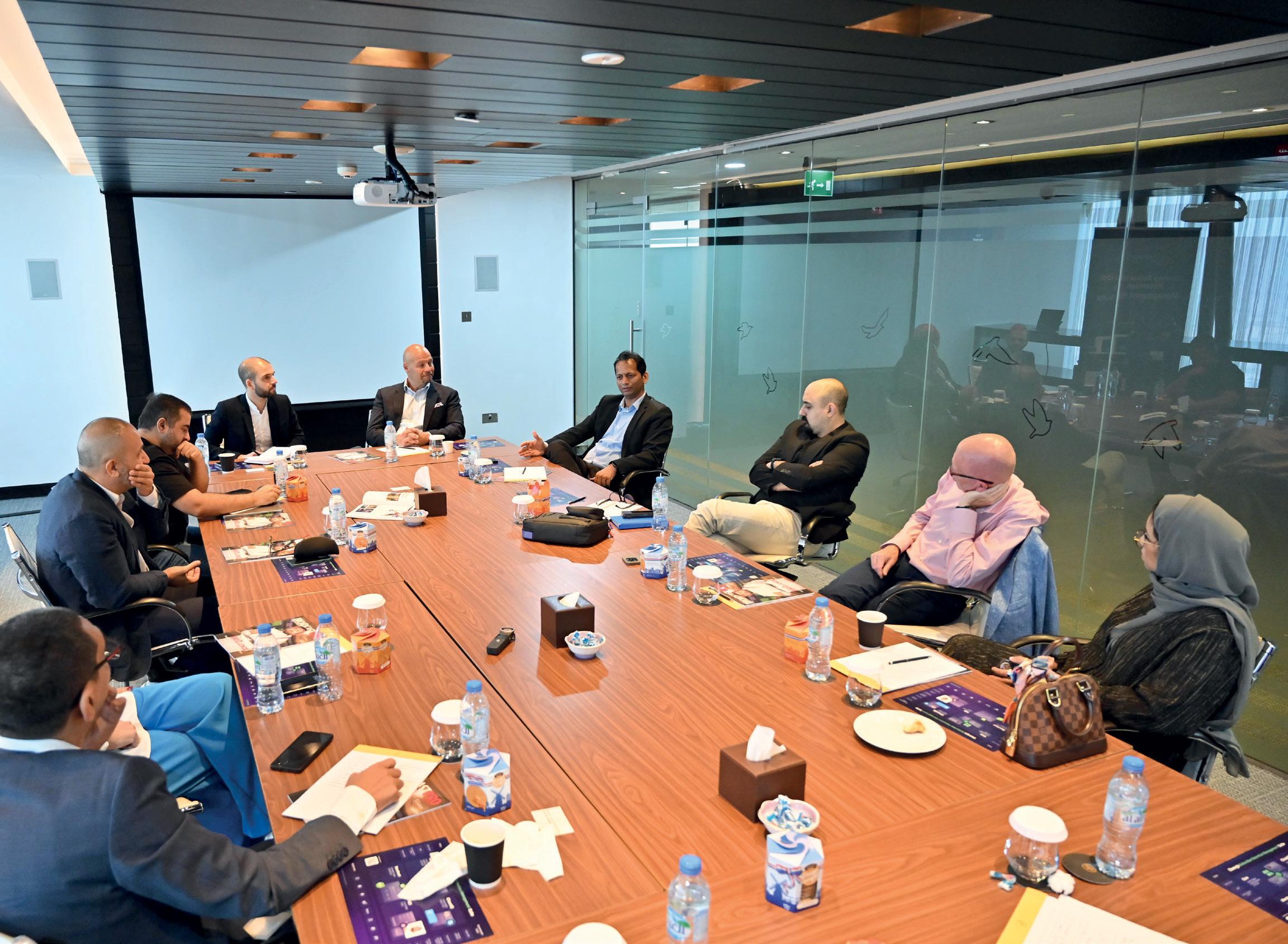
costs and multiplied renewal spend, sport is a different ball game.
“You have daily passes, monthly passes, event passes, and even that’s difficult because you want to see at the beginning of the season what you pay for, and against that you want to see subscriptions. The day passes they have in NFL for instance is a completely unique model, one that all leagues would love to have, but difficult.”
LTV on sport is not comparable to entertainment, and the moment a season or league is over people will churn, “unless a new league is happening
within the same genre”, commented Arshad. “For us, it’s contributing to our profitability, which is why as a company we are investing in multiple leagues with the same genres.”
“In the realm of sports, particularly cricket, e-commerce platforms are forging partnerships and providing subscription services. Their aim is to merge streaming and e-commerce, effectively seeking to integrate the two experiences,” added Saldanha.
E-commerce platforms need live content, and with evolving consumer behaviour the future at a certain point
will be people moving away from different apps and staying within one app – the aggregation of content from all partners into one ‘super app’. This app-level integration could modify metadata to present a library of prime content in one app with a single signon and single payment mechanism.
With many parts of the globe experimenting with the model, Dubai Media has been researching and testing a prototype.
“Super apps will come but there is the need to discuss rights, content acquisition, is it something we introduce




today, will people accept it, would I want to read the newspaper on an OTT platform? Would I switch from a movie or a series to play a game? Many questions, and the audience is varied,” stated Heba Al Samt, “and they’re not looking for a service as much as something to keep them entertained.”
However, it’s about the seamless experience that comes with a super app, stated Yango Play Head of MENA Content Production Joe Al Khawand.
“It’s a click away – one icon, one subscription, one single app. Movies, series, music, games within the same app and especially Yango Play, which is powered by AI. The result is a
We leverage AI in billing automation, which helps us segment customers and offer a stepdown charging mechanism
CTO, STARZPLAY
whole new connected experience.”
A diverse content library is inextricably linked to profitability and most platforms work around enhancing their body of content, aiming to effectively display and make that more accessible. Having exclusive content has its advantages to an extent, but not in the long run, pointed out Al Khawand.
“We produced a Saudi sitcom called Sakf El Waled during Ramadan and it did very well, and now we are exploring ways to make it more visible. We have a lot of talent – writers, directors, actors – and they want to be seen as much as possible.” That way, exclusivity is maintained for a while before opening the gate to partnerships to amplify everyone’s content spread.
“And adding another source of revenue at the end of the day,” said Karim Morgan, Head of Digital Technology, Asharq News. “Artists don’t care so much about the money as much as being seen, and if you limit their reach to a certain subset of platforms or audience, they will find somebody else to produce with.”
As OTT players explore viable models, have multiple rotating packages and more, the fundamental point is that there is no secret recipe. “That time
when we were looking at OTT as an extra service, as a must-have because we needed our content to be viewed by audiences everywhere, that phase has gone. The objective right now is to make money,” said Nadine Samra. “At Weyyak we’ve done successful productions and syndicated them for global visibility, but as a production house the constant challenge is: what’s next?”
Barry Mehdizadeh, Product Director, Shahid, MBC Group, couldn’t have agreed more. “We have reached a

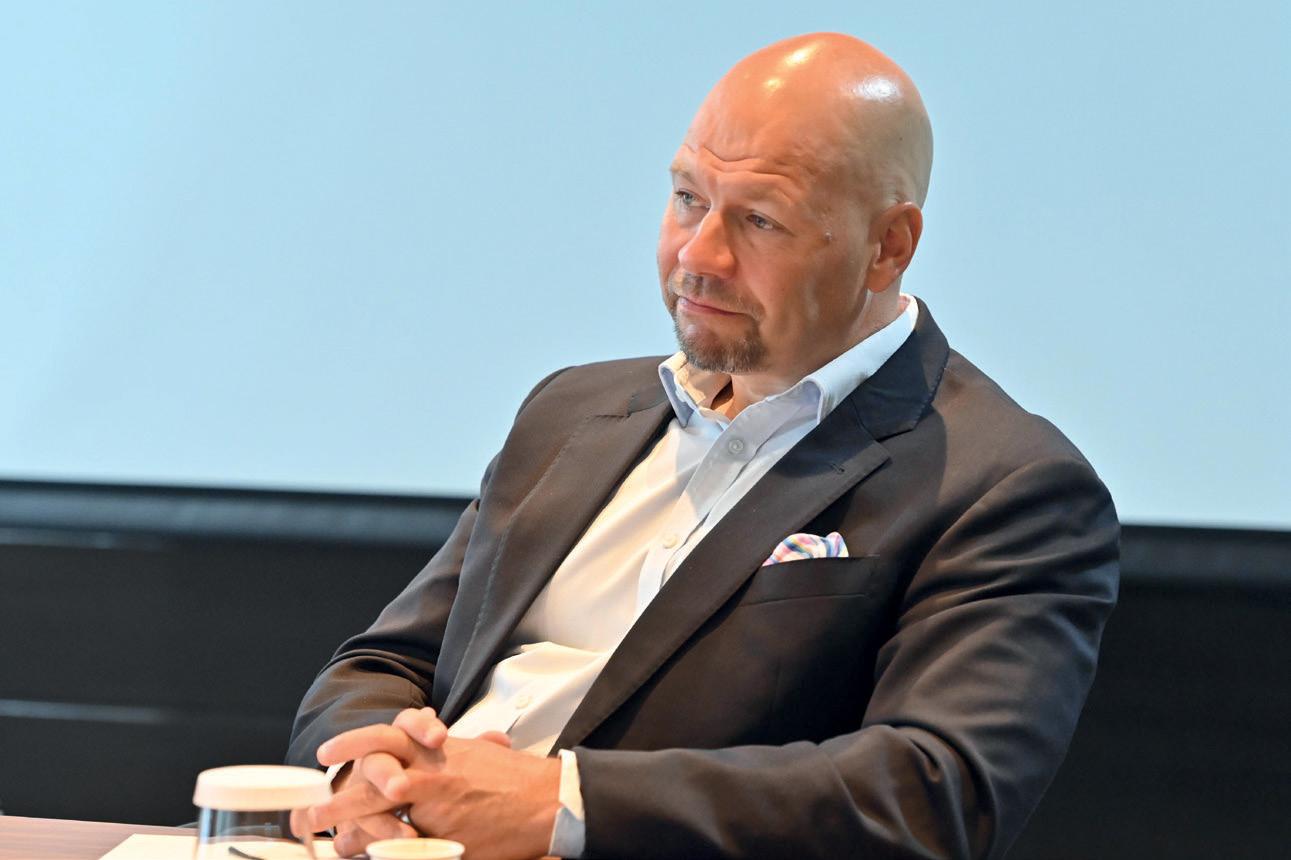


certain maturity, a level where OTT is an entertainment commodity, a valueadd service to another service, to a TV, a telco bundle, used by users as their main entertainment TV experience. And now, what’s the next innovation?”
He added that Shahid offers a full hybrid model beyond SVOD and AVOD “with a set of FAST channels”.
While challenges come, companies adopt new technologies to tackle churn and retention struggles. Data-centric companies look at data segmentation
for their products and identify ‘golden cohorts’ through a mix of watch time and different pieces of content that they aspire to bring closer to all the other cohorts, to limit the probability of churn, said Gai. These insights can be turn into automated marketing campaigns to prevent churn or win back subscribers and maximise return on investment.
Planning profitability by acquiring more market share, businesses leaned towards profit optimisation or cost optimisation. Many OTTs fail because of cost that’s out of control. “Cost of content, whether acquisition or production; cost in marketing (unnecessary spend); and third, technology. If you can control the three, automatically you’ll see the light,” said Morgan.
“Cost optimisation becomes difficult as the content and platform delivery cost is getting expensive, not just for us but for all OTT players. Everything has changed – compute, storage, CDN and the costs never reduce, they only keep growing,” added Arshad.
Adopting a hybrid approach means optimising the CDN as well as acquiring quantum rights so that customers stay for a longer time. From a sports league

We have a lot of talent – writers, directors, actors –and they want to be seen as much as possible
JOE
standpoint, optimising income to create the best digital football experience for fans is crucial, said Van Dam.
As companies look at ways to improve their business, customer lifetime value (CLV) metrics help them make decisions on promotional strategies.
“When the customer first comes in, he’s watching 100% so habitually two hours a day, and then after a fortnight that drops by 50%, and then further down. Our goal is to keep him to those two hours a day,” said Saldanha. “We make sure he is always catered to. At OSN we have premium content straight out of Hollywood studios, sometimes same as US hours. And something we

learned from the traditional pay-TV business is that of drip-feeds, week on week. With drop-ins, the customer is not going to binge watch and move away.”
The importance of personalised communication with existing audiences is central to CLV. OTT platforms do either one of the two extremes, and finding the right balance is key to retention. Another thing that everybody overlooks is UI, said Morgan: “This is why we see platforms like Netflix sustaining the market, even though they may not be operating at a profitability; the UI is so elegant and easy to use, and you have the family plans, segregated accounts, kids
only, all these features built into the UI.”
StarzPlay has taken a step-by-step approach in increasing lifetime value.
“We are not just B2C but also offer B2B2C services. We host different segments and brands within the same app, charging customers and providing them with appropriate entitlements,” said Arshad. “We leverage AI in billing automation, which helps us segment customers and offer a step-down charging mechanism. This allows us to charge our customers at a convenient price point.”
Hybrid monetisation through automated workflows is beneficial when trying to adapt to categories of customers


who subscribe and cancel immediately, optimising the ‘cancellation journey’. For instance, ensuring when a person is about to click and unsubscribe that the right recommendation is made in the right cadence, so that when they come in the next time they are tempted with the offer of an upgrade.
Companies are also resorting to AI in their call centres that comply with regional identities and nuances, so that the caller feels his issues are understood.
“Because I’m handling CX and CS, we make sure the sensitivity in the market is kept in mind. Even on social media, we pay a lot of attention to how we express
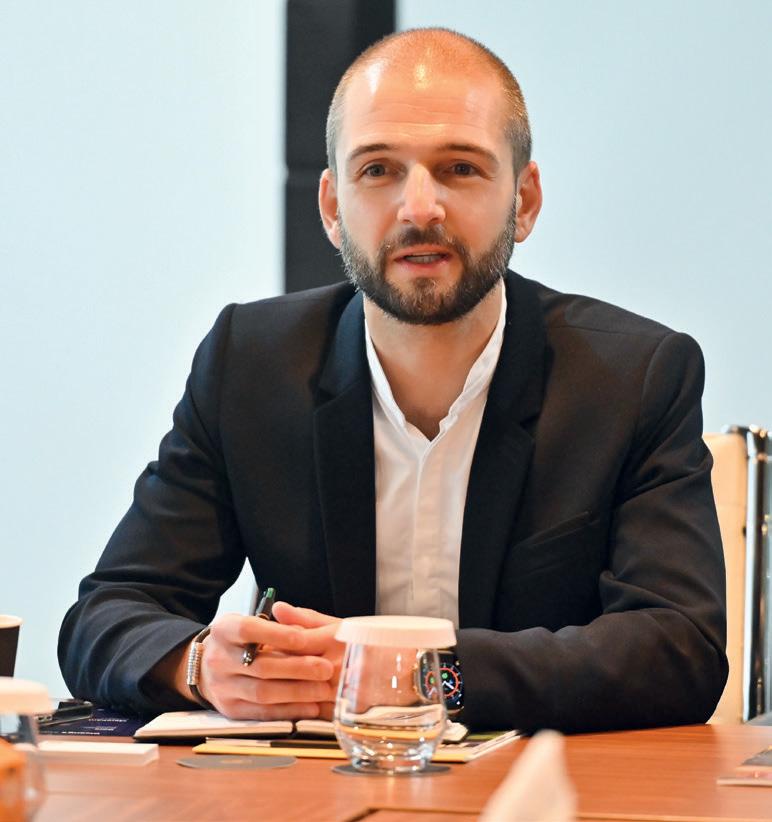
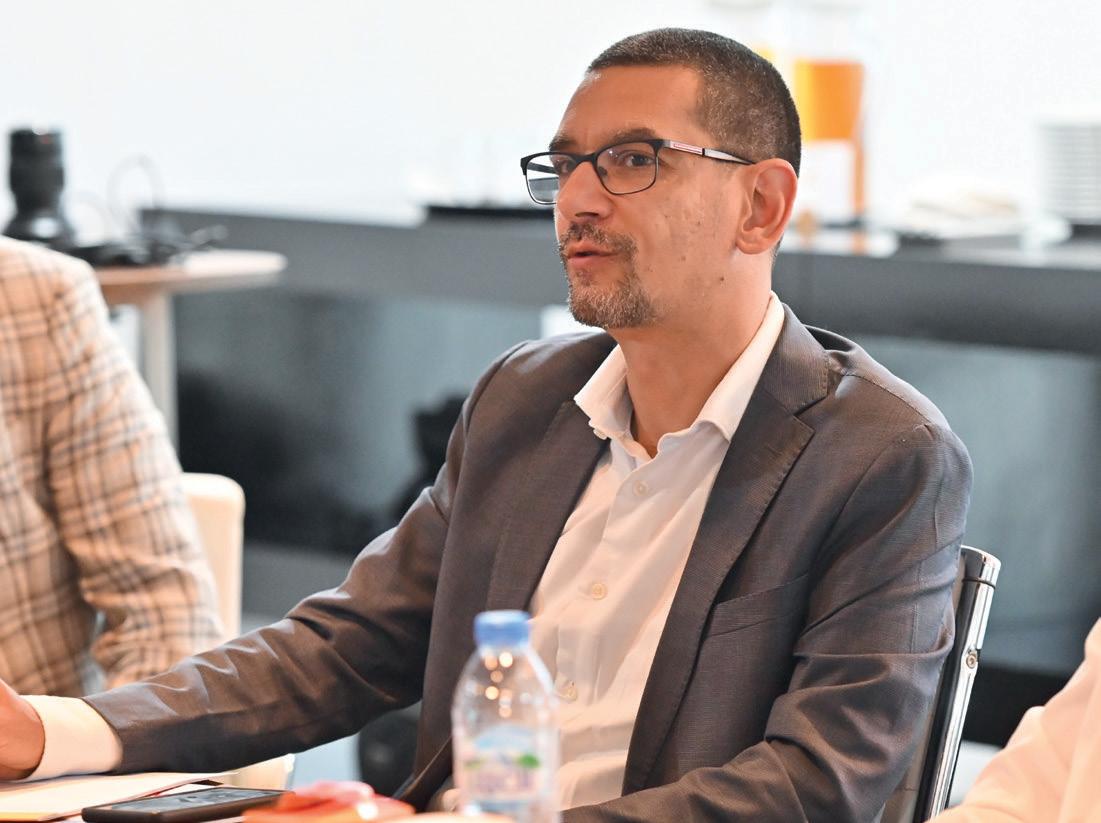
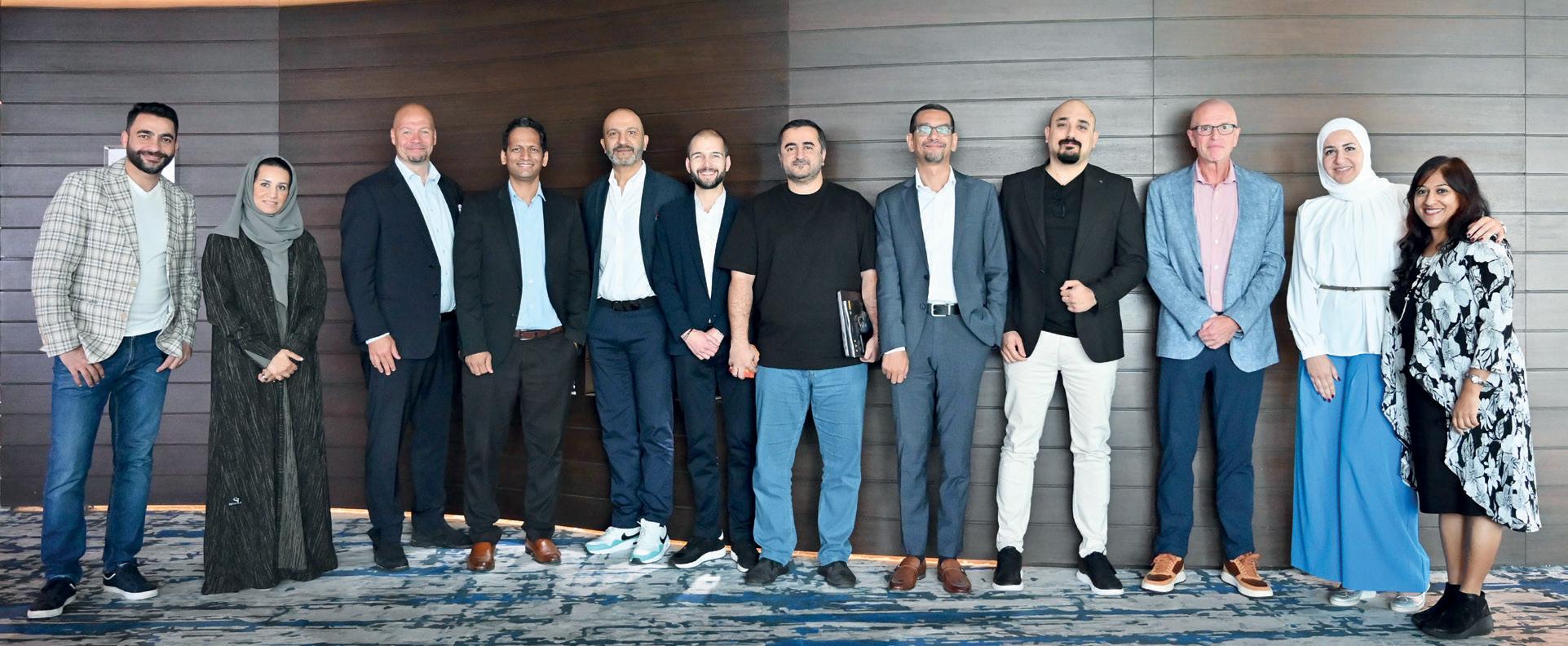
content on promotions, the words we use and the accent,” said Mehdizadeh.
More call centres are becoming less people-driven; chatbots handle about 30-35% of calls, and when the bot doesn’t have answers it routes the call to a human being.
“What we have also done to optimise the cancellation journey is get the system to analyse a call; if it picks up a possible withdrawal, it will say we need to serve retention offers instantly,” said Saldanha.
One of the key metrics to retention is satisfaction, and if a customer is dissatisfied he will most realistically leave. Looking at the best-in-class, the Netflixes of the world, churn metric trend rates is around 2-4%, followed by others at 6-8% and then a host of companies that fluctuate between 10% and 15%. Working on ways to decrease churn rate, everyone agreed the aspiration was to get to the 8%, with content playing a major role.
“Investment in innovation can work, but without the right content, no matter how much the innovation, the customer will never stay,” said Al Samt. “You can have the best look and feel, interface, services, modules, everything, but if you don’t have the right content, they’re going to watch
whatever they want to watch and leave.”
The participants also mentioned a Ramadan trend – a spike at the start of the Holy Month and severe churn after. Whether it’s originals, sequels or popular series, you still face a dip, and that is a fact for any platform that offers Ramadan content, said Al Khawand. The spike stems from the fact that most content providers that cater to Arabicspeaking audiences buy at least 50% of their content prior to the season.
“I’ve seen the traffic during Ramadan
At Weyyak, we’ve done successful productions and syndicated them for global visibility, but as a production house, the constant challenge is: what’s next?
NADINE SAMRA, CHIEF BUSINESS OFFICER, WEYYAK
exceeding the combined traffic from the other 11 months,” said Morgan.
The solution, everyone agreed, lies in finding the right balance between scheduling new episodes for series and shows, to minimise churn and keep households engaged with content made not just for Ramadan but with a longer innate appeal.
So where do viewers spend their time? While the Prime video proposition drives e-commerce, YouTube remains the most-watched channel. “That’s probably our biggest challenge. That pie gets divided among multiple OTT providers and then we fight for the smaller portion of the pie,” said Samra.
As increasing competition impacts profitability, higher AVOD and higher subscription remain the two revenue streams. Operators need to also implement better loyalty programmes – early access, a discount, partnership bundles and, most importantly, retention campaigns.
“The cost of acquisition is much higher than the cost of retaining an existing customer. Focusing on churn is the key to profitability, instead of trying to acquire a new customer when you don’t know how long they are going to stay,” said Morgan.
With a surge in the uptake of FAST channels, we look at the key factors that help boost viewer engagement and monetisation
The free ad-supported streaming television (FAST) market is expanding at an extraordinary rate. Digital TV Research predicts that global FAST revenues for TV series and movies will reach $17bn in 2029, and the MENA region is expected to be a significant contributor. With FAST channel revenues in the region hitting $7.2m in 2023, MENA is poised for even more growth in the coming years, according to industry analysts.
In this booming market, personalising video content is crucial for several reasons. By tailoring content to individual preferences, service providers can significantly enhance the viewer experience, making it more engaging and relevant. Personalised content also enables more effective monetisation strategies. By understanding viewer preferences, service providers can offer targeted advertisements, personalised channels and content bundles that are more likely to resonate with the audience and result in higher ad revenues. With content personalisation becoming a necessity, video service providers need to solidify their standing in the ultra-competitive FAST market and find ways to drive viewer engagement.
To elevate the user experience, video service providers must offer more advanced forms of personalisation, such as targeted TV advertising, personalised channels, tailored personal pages, personal search and recommendation results, and content bundles.
In the past year, targeted TV advertising has transformed the media industry, outpacing all other business models to help video service providers maximise their revenues. Worldwide, addressable TV revenue is expected to climb to $87bn in 2027, accounting for one-fifth of all global video ad buying.
Targeted TV advertising is an important pillar for monetising video streaming services; however, its success relies on attaining valuable, in-depth insights into viewers’ behaviours and preferences. Forming partnerships with local and regional advertisers is also critical to personalising FAST channel ads. Such collaborations can ensure video service providers deliver tailored adverts that are accurate and culturally and linguistically relevant. Furthermore, integrating interactive and shoppable ads is an effective way to boost viewer interaction and drive higher ad revenues.
Personalised FAST channels
Offering personalised FAST channels is another solid strategy to boost viewer engagement, reduce churn and increase monetisation. Driven by usage data, viewing preferences and subscriber consumption patterns, personalised FAST channels address the age-old dilemma of viewers not knowing what to watch.
A major trend in the FAST market is content bundles. Some of the biggest names in the media space have joined forces to offer consumers all-in-one packages of entertainment choices. Bundling FAST channels increases advertising revenue by attracting larger audiences and enhancing cross-promotion. Furthermore, this approach improves customer retention through a varied content offering and better user experience. Content bundles can be personalised through advanced technology and data analysis, allowing platforms to tailor media collections to individual user preferences, enhancing engagement and satisfaction by making the content more relevant and appealing. While the degree of personalisation can vary, the ultimate goal is to optimise the viewing experience for each user.
Bundling also provides operational efficiencies, greater negotiating power with content creators, and market differentiation. It also enables targeted advertising and subscription upselling, further boosting revenue opportunities for video service providers.
The key to successfully delivering all the above lies in effective audience segmentation. Broadcasters and service providers can effectively isolate specific audience segments based on




first-party TV data, analysing usage flows and identifying consumption patterns. Broadcasters and service providers can further fuse additional data from third parties, including shopping and browsing interests of their viewers, leveraging AI and ML algorithms to generate sophisticated, highly accurate audience segments.
Audience segmentation combines intuitive rule-based queries, AI/ML models and generative AI capabilities to segment viewers based on various geographic, demographic, psychographic and behavioural criteria. This includes age, family composition, TV consumption preferences in terms of both content (specific programmes, movies) and genre (cooking, sports, soaps), as well as viewing hours and viewing habits (late night or morning, binge watching). Once video service providers gain a holistic understanding of their audience, they can then target distinct groups with common characteristics or preferences.
For targeted TV advertising, audience segmentation allows the replacement of ads aimed at specific audiences during linear primetime content. Consequently, channel providers can charge premium rates for advertising while also reducing churn rates, as viewers tend to respond more positively to targeted ads, resulting in increased monetisation. Audience segmentation can also be used for engagement monitoring and improvement purposes. Audience segmentation technology allows video service providers to identify viewers who are not watching personalised

channels, enabling them to improve the personalised FAST channel experience.
Today’s service providers are inundated with data, but they don’t know how to maximise it to drive viewer engagement and increase monetisation. Audience segmentation brings video service providers solutions that go beyond mere data aggregation, providing actionable insights.
Adopting an audience segmentation solution that collects and analyses data from every part of the video delivery ecosystem – backend servers and databases, set-top boxes, player apps, content metadata, user interactions, even third-party data – will ensure that video service providers have a complete understanding of an audience and the market dynamics guiding their decisions. Likewise, pre-trained AI/ML models are invaluable. Allowing video service providers to create sophisticated segments that maximise impact, these expand on the capabilities of making simple queries to produce cross-referenced segments that pull data from multiple categories.
ANNE-SOPHIE CORNET IS PRODUCT MARKETING MANAGER AND EYAL YOSKOVITZ IS DIRECTOR OF DATA-DRIVEN PRODUCTS AT VIACCESS-ORCA
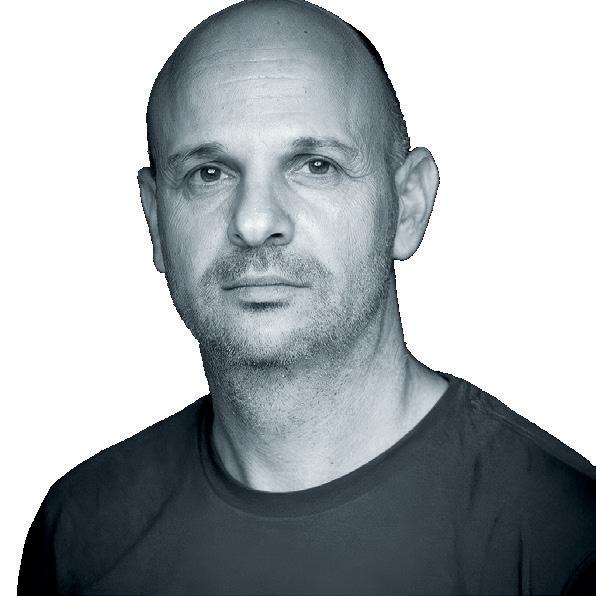
With sports dominating the entertainment landscape and viewer demand for diverse formats surging, industry professionals at a BroadcastPro ME roundtable explored the changes in sports consumption and what spread to offer a sports-hungry audience
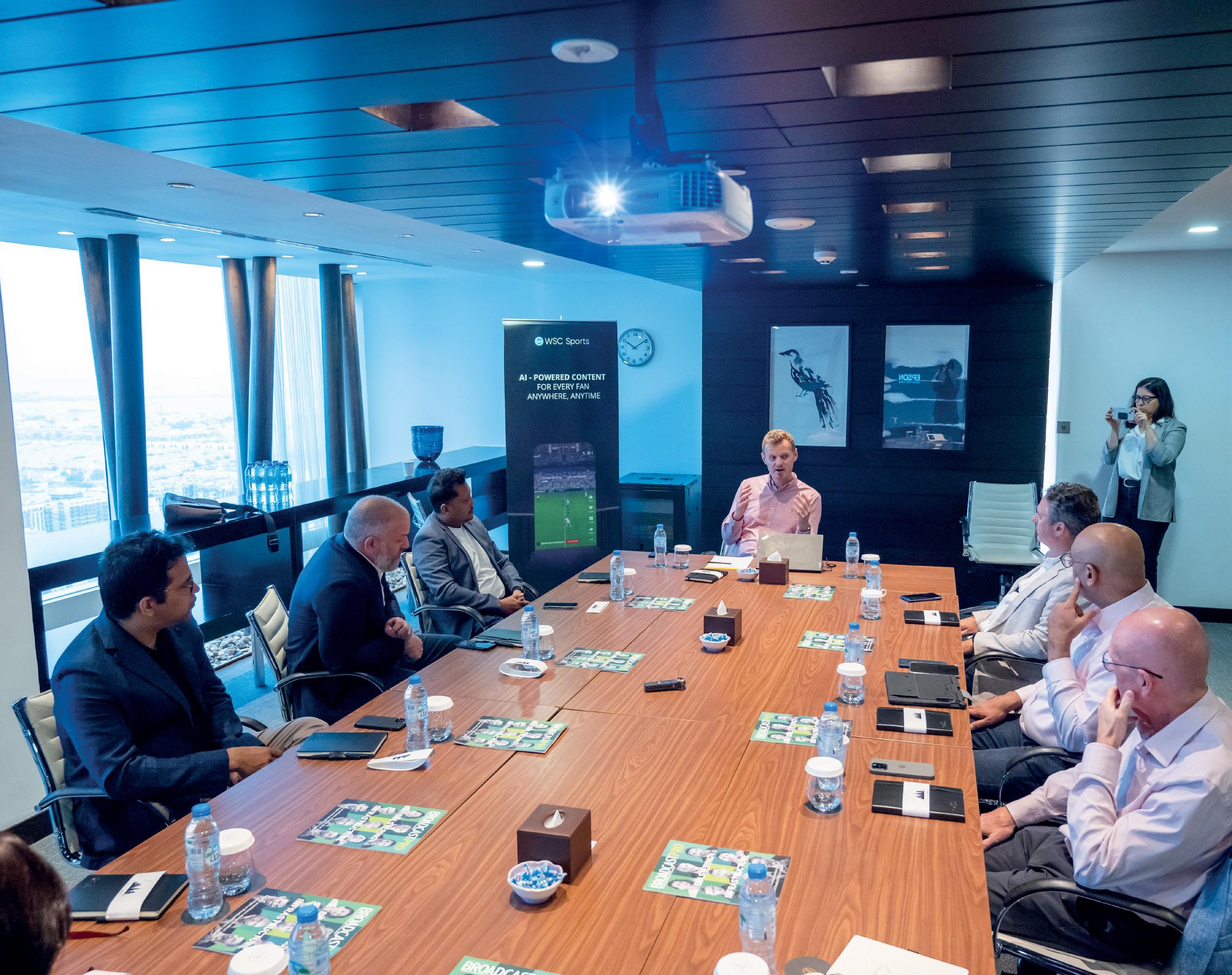

Beyond the growth of broadcast services and audiences spread across devices, sports consumption follows a brisk upward trajectory. Preferences change swiftly and sports media rights holders intensify operational methods as fans meander through apps and devices. With the popularity of short-form content, highlights are often on-the-go. However, even as digital media influences sports consumption and transforms the globe, the linear TV domain continues to reign.


Understanding the paradigm shift in producing content, changes in sport consumption and its impact on the sports broadcasting world, content experiences and what’s next in AI were some of the subjects discussed at a high-profile roundtable hosted by BroadcastPro ME recently, in conjunction with WSC Sports. Presided over by Ross Munro, Head of Commercial for WSC Sports, the speakers were Amill Lone, CEO of Saudi Sports Company (SSC); Danny Bates, co-founder and COO of StarzPlay; JP McKerlie, VP Marketing & Sales of TOD/ BeIN Media Group; Peter Van Dam, COO of SPL Media House; Sunil Joy, Head of Content at Evision/e&; and Tanweer Anwar, Head of Monetisation at Noon.
As businesses maximise video content to increase reach in real time, Munro set the tone by trying to understand some of the challenges and lack of resources rights owners face in an ever-changing landscape.
“As we are serving platforms with completely different content requirements, the media manager must be creative with sizes, types and quality, and build responsive formats,” commented Peter Van Dam of SPL Media House.
With sports consumption becoming increasingly dynamic, fans are no longer focused solely on the game; they want to dive deeper, with more of a focus

on players and what goes on behind closed doors. Hence sports media rights holders are now creating playerspecific content. This shift is evident, with Gen Zs consuming content in bits and pieces “and the requirement for snackable content”, remarked Sunil Joy of Evision/e&. “The IPL is an obvious example. If you look at Insta Reels, a popular player gets over a million likes just by walking into the field – that’s the impact of bite-sized content, and we need to begin with that kind of engagement.”
Shoulder content is significant for sports
On our e-commerce platform, ... the moment we couple games with content, consumption goes up
TANWEER ANWAR, HEAD OF MONETISATION, NOON
consumption, commented Noon Head of Monetisation Tanweer Anwar: “Sports is not just focused on a match itself. It’s like a multi-course meal. What one is looking for is obviously the sports and also the shoulder content, especially stats and highlights, etc – like what’s the next upcoming match, the scoreline, what happens off the field before an actual game, during breaks and so on.”
Which then brings up gamification. “On our e-commerce platform we see that the moment we couple games with content, consumption goes up. Duration is another factor, where traffic on the platform spikes during specific periods. Identifying these trigger trends is important for broadcasters.”
Generating interest is quintessential to driving value into the game and consequently the way everything gets funded. Players can create a buzz, but the bigger objective is reaching more viewers worldwide. Traditionally sport was broadcast onto a linear platform, so broadcasters built studios and the whole facility was built into that stream.
“And the commentator’s role was to educate the audience on what was
happening in the game,” stated JP McKerlie from TOD. “Digital changed that mechanism, and suddenly all the other parts that you’re cling-wrapping with the production become part of the story. The minute a player steps onto the pitch, everyone’s paying attention to the screen again – it’s triggered by some other distribution channel and broadcasters are now looking at distribution strategy as part of the selection process. Fifty percent of the engagement in sport is not on linear anymore, it is somewhere else.”
Danny Bates from StarzPlay remarked: “We’re seeing rights holders asking for social strategy and a lot of leagues are bringing social teams into the region to support the rights holder. LaLiga, Serie A, among others, see that cycles are challenging, that they need to help build the product and assist in having a clear digital strategy. The way NBA produces content for example, during the week, in the lead-ups, is supported with a clear file structure; it allows for consistency.”
Rights holders don’t always have the resources to get that maximum exposure and leagues need to step up support for them, agreed the panellists. There are many challenges that come with the complexity of scaling content production, especially as viewers want to see football
We need to look at dispersing content to adapt to various generations that are watching the same content
AMILL LONE, CEO, SSC
throughout the year. SPL tries to provide shoulder content to the rights holders to ensure maximum exposure to the league. This includes non-match days and the off-season, said Van Dam.
As you produce a high-quality version of a six-second clip and 50 platforms across the planet get to use it, you get that consistency, remarked McKerlie.
“It is something you want, because you’re going to get varying degrees of quality from each of the broadcasters depending on their scale and capabilities. It becomes a case of which one to pick, with so many options – what are the segments interested in sport, which platform, what’s the territory, all become functional requirements.”
As players and teams strategise via social media, Dror Yousef, Business Development Manager at WSC Sports, queried whether global broadcasters were serving demand or urged to manage a community.
“It’s a bit of both,” stated Bates, “but I guess you’re serving what you want to. It’s about capturing the demand and making that demand aware of where that product is. But to capture that, you need to connect with that consumer.”
Making sure to have a good product and turning it into something you can develop is key, the panellists agreed.
“You can create all the short forms and everything, but our Saudi audience can be unforgiving,” noted Amill Lone, CEO of SSC. “We’ve had missed goals, different greens of grass, everything you can mention, and all of that resonates in how we now build our strategy. We see the trends on social media, work closely with the league, see our growth impressions and the number of people coming on, and it’s about taking that plunge to develop a strategy and monetise it.”
The linear versus digital viewer is another factor to consider, pointed out Noon’s


Anwar. “The mindshare is less for someone on digital because notifications, messages and so on continuously pop up. It’s easy to drop out, unless it’s Ronaldo or a penalty shootout or a last-minute key moment of the match. So, the same content and form can’t be served on both platforms, it must be modulated and customised accordingly.”
It’s like having multi-cuisine restaurants and specialty restaurants, seconded Joy. “Is one broadcaster taking care of different requirements, or do we have those specialising in one format or content? A scenario where somebody will pick up the digital rights and make
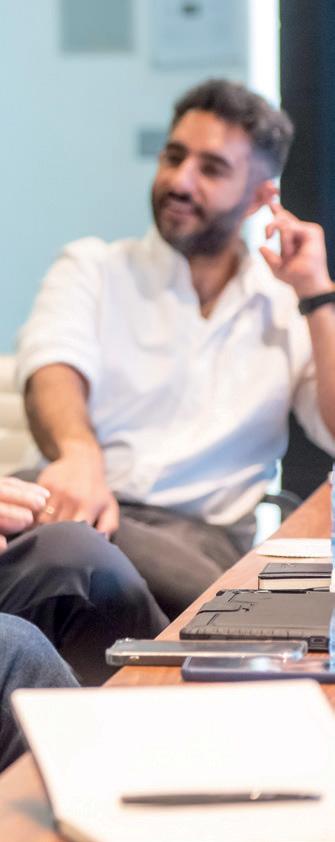





sure the digital format is managed in different ways? Having said that, traditional widescreen consumption is still the most attractive to viewers. The future lies in a multi-platform approach, offering engaging, on-demand content that is readily available on their preferred mobile devices, while recognising the enduring appeal for live, high-production broadcasts.”
Though linear rules still, multi-screen adaptation is edging into the viewing space. “In Saudi Arabia specifically, linear consumption is high. Culturally, the viewing habit is family-oriented. We need to look at dispersing content
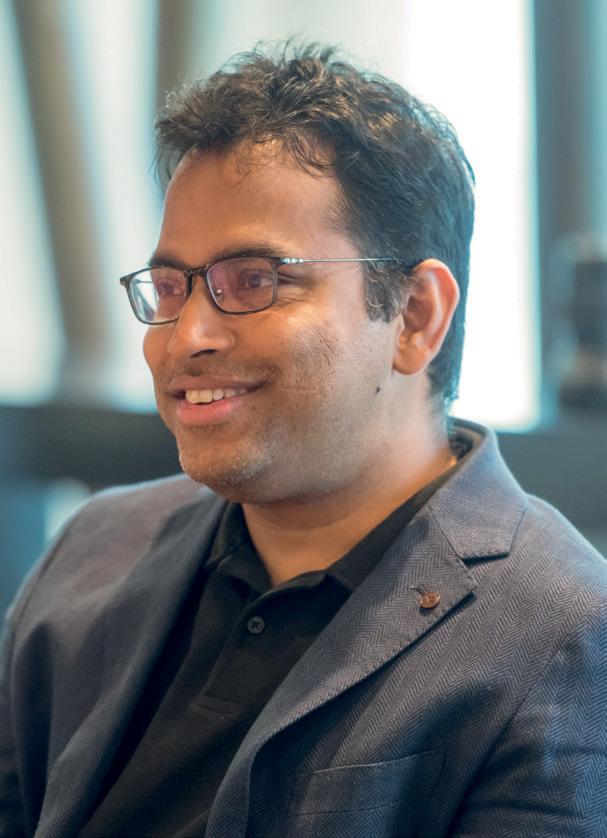

to adapt to various generations that are watching the same content,” said Lone. “SSC exclusively resides on nine channels, and among all that entertainment content sport is what’s bringing everyone in, and we have seen that with Shahid – how important sport is to that platform, because it is driving the rest of the content as well.”
Sport has that organic following. “People come to you,” said Bates. “One of the challenges we face is whether your sports account is helping build the reach on your entertainment accounts. And then balancing posts on a weekend between entertainment
shows and highlight clips. Do you want to put that goal out straight away, or hold that for an hour after the game?”
As fan engagement drives digital content, rights holders use it to harvest data. Social media metrics potentially affect subscriptions, and digital content converts to a new revenue source in terms of advertised revenue. “For someone licensing the rights, it’s important to mine that data which can help broadcasters decide more strategically what they need to do,” said Joy, “and with AI allowing data crunch in real time, it’ll help during long-duration games or when there are multiple games happening to create snippets or snackable content.”
AI is helping improve organic search by getting clips up in real time with metadata “and we are seeing the impact of doing that; it’s become more relevant as we build our scope”, noted Bates.
With standard game highlights, different aspect ratios, languages, graphics and sponsors, Munro asked if hitting all deliverables with a manual operation becomes nearly impossible.
“It’s a function of scale,” remarked McKerlie. “The facility provides capacity, and the capacity gives you the ability to focus on quality. So, you can change where you focus. It doesn’t mean you’re going to; it means that you do more if you choose to do so. But can you survive without it? Can you do better with it? Yes.”
“AI helps move up with the same resources, in terms of value-added and non-value-added activities,” added Tanweer. “There was no requirement earlier, now there is. It is a force multiplier.”
Given the multi-faceted audiences of the Middle East, localising content to fit wider and diverse audiences is key, and one aspect of that is the
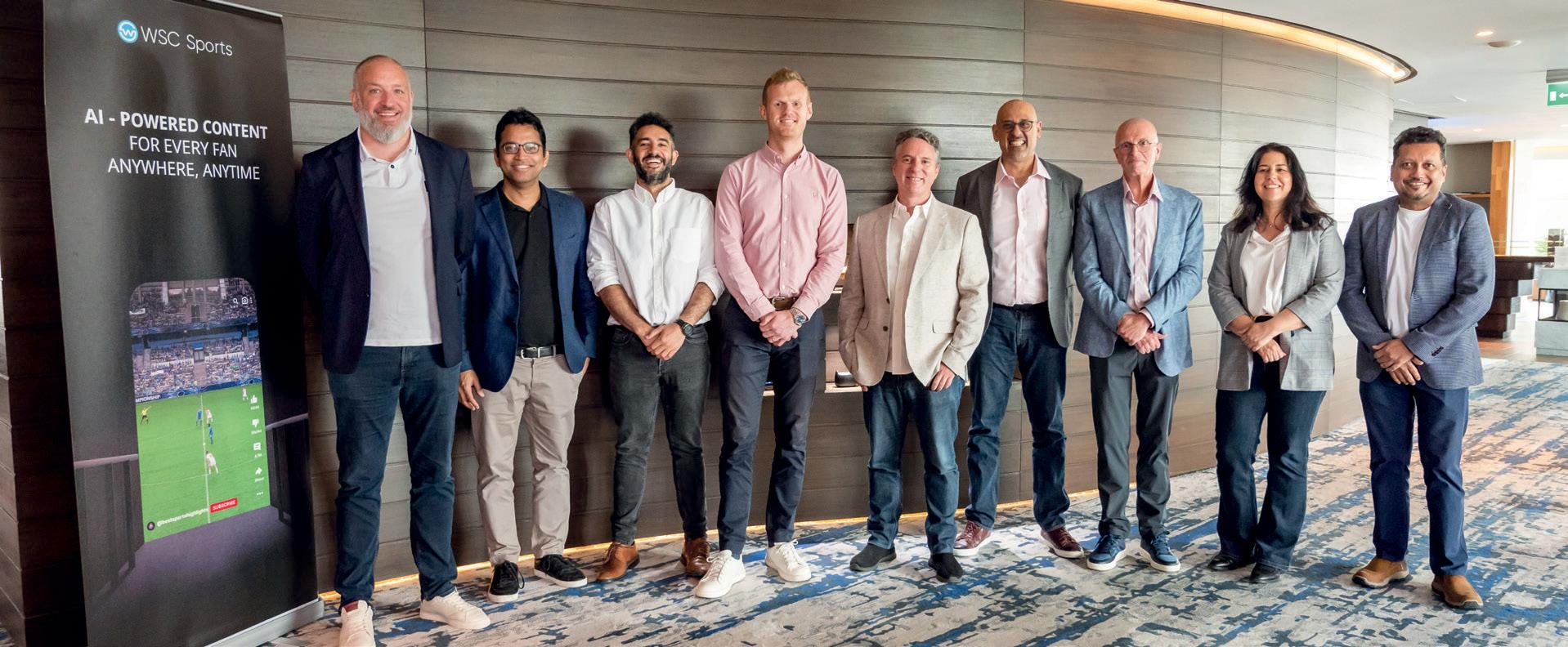
commentary, a big draw when seasoned, recognised commentators bring their talent and expertise. “As a football fan, it makes a huge difference. If I don’t have my commentary on, I do miss it in the game even though I enjoyed the game. I like to see the pundits before the show, their half-time argument, it’s all part of the experience,” said Bates.
Indexing the main game moments and then creating highlights automatically on the back of it is trouble-free, but to automate the copy or the commentary is often a challenge to which WSC Sports has a solution, pitched Munro. “Sports models are specific and adding commentary post-production becomes tricky because it cannot be applied from an open-source generative AI. So we built language models and now we can apply Chinese, Spanish and German commentary after the game because we have got the metadata.”
A varied, assorted commentary typically helps unlock access to a more targeted audience, noted Anwar. “For brands that are advertising, language as an option is very important to open new income from a specific audience, especially if you’re looking to access people with certain language
preferences. This would be difficult in a linear TV set-up. Tailor-made ads and ads from specific brands can be served, which otherwise won’t be possible.”
Having a massive amount of content is one thing; making that copy more descriptive is where generative AI steps up the game. A built-in captioning tool, the choice of words and freshness drive more
“[The] commentator’s role was to educate the audience on what was happening in the game. Digital changed that mechanism, and suddenly all the other parts that you’re clingwrapping with the production become part of the story
JP MCKERLIE, VP MARKETING & SALES, TOD
engagement, the participants agreed.
Just as highlights are super important, some of the bestperforming content happens away from the game and often tends to go viral, Munro pointed out.
With tech innovation moving exponentially, the way forward is a learning process, the participants concluded. Developing responsive strategies to promote approaches – the continuous ability to deliver quality service, working with the leagues, rethinking ways of monetising the fanbase, employing AI to leverage the commercialisation opportunities, ROI – all the collaboration will benefit the larger end of sports storytelling. Mobilising AI offers a chance to work in combination with people’s talent and gives them more time to be better at what they’re doing. “That’s the real power,” noted Bates. Content rights are not cheap, and neither is making content available on multiple platforms. Operators need to bring technology that makes commercial sense, while audiences continue to dictate what’s to come and drive content consumption patterns and the way sports will be broadcast.





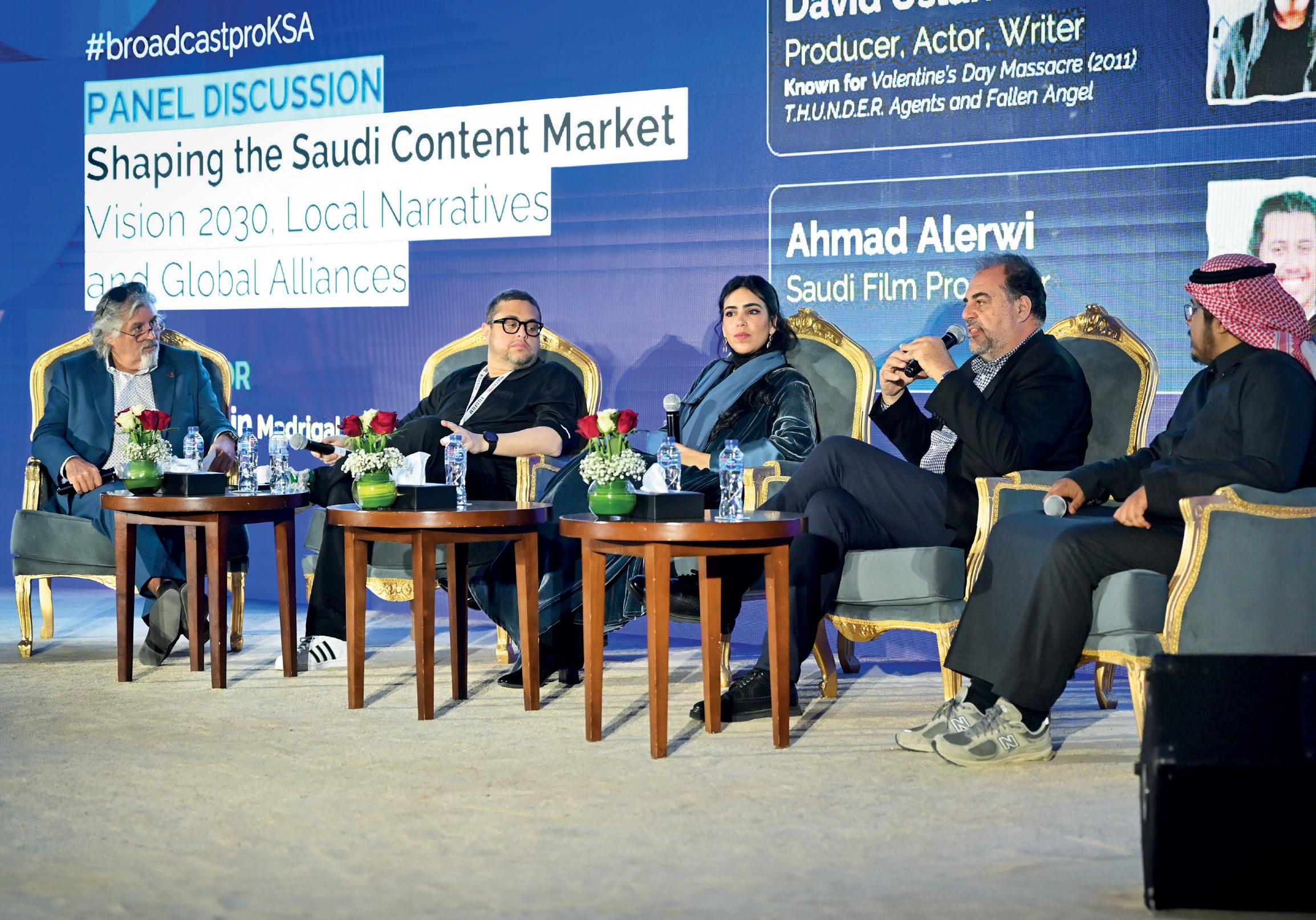
Local content is booming in the Arab world and the opening up of Saudi Arabia’s media landscape has especially seen an unprecedented rise in creative and local productions. At a BroadcastPro panel in Saudi Arabia, regional stakeholders discussed leveraging local narratives, nurturing talent, investing in film infrastructure and achieving success with hyperlocal stories



BroadcastPro ME brought together a cross-section of high-profile individuals within the content business for a panel, moderated and organised by Hans Fraikin, former Twentieth Century Fox veteran and Abu Dhabi Film Commissioner, now Global Senior Advisor at Arthur D. Little. While each person on the panel represented their own company, their backgrounds made them naturally representative of the larger content community. Panellists included David Uslan, a well-known Hollywood producer and heir to the Batman franchise, helmed by his father Michael Uslan; Zeinab Abu Alsamh, GM of MBC Studios KSA; Wayne Borg, Managing Director of Media Industries, NEOM; and Saudi film producer Ahmad Alerwi.
In the space of a short six years, Saudi Arabia has ushered in tectonic changes in the media and entertainment landscape. Vision 2030 set the ball rolling and its impact can be measured across themes such as flourishing Saudi film talent, a boom in investment in film infrastructure, global collaborations, curiosity about Saudi culture and the subsequent demand for local and hyper-local storytelling, noted Fraikin at the start of the discussion.
MBC’s Zeinab Abu Alsamh and Saudi filmmaker Ahmad Alerwi are two industry talents who have risen through the ranks as the media industry burgeoned. Alsamh’s eclectic career trajectory includes stints in advertising in Japan and Saudi Arabia. These paved the way for a role in production at Saudi Broadcast Authority (SBA), after which she joined MBC. Alsamh used what she learned from advertising to concoct a recipe for success in broadcast.
“In broadcast, content is the product and production is the kitchen of that ecosystem. Understanding the complete production chain helps you understand a very fast-moving industry. That
We are seeing a new wave of local production companies that are trying to establish themselves, and the financial and creative potential of such ventures is huge
knowledge helps you make content that moves consumers. Whether it’s a film for the audience or a consumer product for households, it needs to hit that emotional insight,” she said. Alerwi recognised the opportunities the seminal industry would eventually yield and began working in media and tech startups. He joined Telfaz11 when it was still a new platform. A penchant for storytelling and an inclination for “anything that brings people together” were key driving factors. In 2015/16, the team created a few short films in Saudi Arabia that were screened in Los Angeles. These ended up on Netflix under the umbrella title Six Windows in the Desert. With the opening of cinemas in 2018, Ahmad decided to get a more formal training in filmmaking and went to the American Film Institute (AFI) in Hollywood, where he did an MFA in film producing.
David Uslan is another industry veteran who saw Saudi Arabia’s potential early on thanks to a close Saudi friend and business partner. “He opened my eyes to what was happening on the ground here in terms of film and television, live events, location-based entertainment, publishing and animation.”
He added: “My family caters to geeks. We need to be where there are communities that are growing local and regional IP [intellectual property] but with content that has the potential to expand into franchises and work on a global scale. Riyadh is one of the greatest places in the world to be for something like that right now.”
He also pointed out the growing number of comic cons across MENA and events like the Red Sea Film Festival that are drawing talent from all around the world. “If you are in the content creation business, if you’re in the franchise business, you have to have one foot here in this country.”
Wayne Borg believes that NEOM Media Industries holds the key to the future for stakeholders like Alsamh, Alerwi and Uslan. NEOM aims to emerge as a regional hub for content creation with a remit that stretches beyond “just the screen and will include gaming, publishing, music and advertising services”, said Borg proudly. It also promises to address the challenges the region’s markets are facing. “We are a far-flung market spanning from Morocco in the west to Oman in the east, and the biggest challenge we have is fragmentation –of infrastructure, talent and industry. NEOM is about how we bring all these elements together in a world where convergence is taking place across the screen sector, into gaming and publishing. We are also focusing on how we can harness and future-proof new tech to redefine processes and workflows more cost-effectively and efficiently.”
NEOM Media Industries envisages its role as that of an enabler and facilitator, one that supports the content creation industry. Borg highlighted, “We’ve supported 38 productions over the last two years – from documentaries and high-end global TV commercials, TV, scripted, unscripted, right through to


feature films, local, into international and Bollywood. There are a lot of creators here, such as MBC, SBA and SRMG. Our role is to help ensure that we can compete as a country and as a region on a global scale, get content out into the global marketplace and showcase what this region has to offer in terms of its storytelling capabilities.”
Creating an environment with a legal and regulatory structure that is highly competitive and has the right infrastructure and talent is another of NEOM Media Industries’ goals. “It’s a regional proposition; it is a global city and a global jurisdiction. We want to be a formidable force as part of a creative global community,” Borg added.
Government policy and strategy are always important considerations in the development of any industry. Fraikin highlighted how the government of Saudi Arabia has adopted a two-pronged approach that includes developing the indigenous and service (content production) industries simultaneously. When Fraikin questioned whether the focus should be on production in the English language for global distribution or in the Arabic language for regional and local distribution, the panellists
unanimously agreed that local content should always be the first priority.
“If it doesn’t work with your own people, it won’t work with anyone. If your own people don’t buy it, others won’t. I am a firm believer in this. The local audience is always relevant in any market. Saudi Arabia becomes even more important in this regard since it is a market that has been not talking about its stories for over 40 years. There is an immense hunger and eagerness to write our stories and to see ourselves represented,” said Alsamh.
Saudi Arabia’s geographical diversity has also fed into content creators’
creativity, allowing local audiences to peel away the layers of Saudi culture. “We get scripts from the Eastern Province or the south about a wedding and it mentions traditions there that aren’t known about in other parts of Saudi Arabia. The local flavour is so appetising for us too. We want to hear the different accents and customs that make us diverse, but also bind us together,” she explained.
If you are in the content creation business, if you’re in the franchise business, you have to have one foot here in this country
DAVID USLAN, HOLLYWOOD PRODUCER
Borg added: “You always have to make content that speaks to your home market. And streamers have shown now that great content will travel and will find an audience of scale. Take for instance the Korean model or the Scandi model. People aren’t afraid of foreign content anymore, nor is it restricted to the domain of arthouse students and theatres. Saudi films are now finding global audiences. Some of the work Telfaz11 has done has gone global and succeeded in sustaining audiences over some time. So it is resonating beyond just core markets.”
The panellists also observed that language is no longer an obstacle to great content going global. “I don’t believe language is an issue. Local and hyper-local are trending. Now


there is a demand to connect more as human beings; there is a lot of curiosity about other cultures and audiences are willing to understand differences,” emphasised Alsamh.
“Human emotions are universal. If the story is authentic and people connect with its emotion, they will rally behind it. What is revolutionary is the advent of platforms that have presented this local content, dubbed or subtitled, internationally. Previously we didn’t have the platform to take our stories to the world; there was no infrastructure to support storytellers.”
“OTT platforms and streamers have opened up the market for people to engage with different cultures and not be put off by subtitles or language,” reiterated Borg.
While Saudi content creators are “good at representing our own stories for our audience, they are tailored for international audiences as well”, noted Alerwi, but added that scriptwriters and filmmakers need to be taken more seriously. “People wouldn’t take it seriously in the past, as they didn’t think there was a financial aspect to it.” The young Saudi producer also cited the need for stronger collaboration between
There is an immense hunger and eagerness to write our stories and to see ourselves represented
ZEINAB ABU ALSAMH, GM OF MBC STUDIOS KSA
producers and writers to push the market. He remarked that ecosystems like Neom Media Industries have the potential to “shift the market”.
“While platforms like Netflix, MBC and Shahid help push our content, it is the likes of NEOM, where international collaborations can potentially take place and talent can shadow and learn from each other, that will boost the content creation process,” he surmised.
For Uslan, an ‘adapt and glocalise’ strategy has been the way forward. However, the path has not been easy. “It’s time-consuming and requires having a team that can shape the content the

right way. We have to bring in the cultural sensitivity and intelligence to make the content right for the local fans here.”
His first movie production in the Kingdom is a testament to his commitment to local: “Everybody except one of the three leads is local. The movie will have a mix of English and Arabic.” He is in the process of acquiring his first local format and excited about adapting it for an international audience.
In addition to producing movies and regional adaptations of popular international IPs, Uslan is also focusing on the publishing opportunities, both physical and digital, emerging in the Kingdom. “Whether we talk about graphic novels, manga or webtoons, there is a huge opportunity to bring in more global IP and localise it.”
Agreeing with Uslan, Fraikin noted the robust and dynamic connection between Japan and Saudi Arabia via anime and manga. This was seconded by Zeinab Alsamh. “Saudi nationals have a very strong connection with animation and my generation grew up with the greatest of animators and the greatest of manga. We’ve had amazing Arabic-dubbed IP. Today, our children also enjoy anime and manga. It’s a

different style and very modern, but the roots are the same. It’s become a part of our millennial heritage.”
The panel lauded MBC’s recent collaboration with Stu Levy at TokyoPop as another testament to Saudi Arabia’s affinity for Japanese animation. “It’s a very smart and strategic move. TokyoPop is not only a great publishing house for manga content, but they’re a conduit to fabulous IP in Japan. And having a company like that partner with MBC creates a great two-way street scenario which gives access to great global IP as well as opens up great distribution channels internationally for local content,” noted Uslan.
Alerwi attributed the growth in manga and anime’s popularity to the lack of other entertainment avenues in Saudi Arabia. “We love animation because we grew up watching it. There were a lot of things that were prohibited; films were not always accessible, so we used to watch a lot of animation. At the time, it was all from Japan or international productions.” He opined that it is perhaps this long exposure to manga, anime and other international television content that has made the local
People aren’t afraid of foreign content anymore, nor is it restricted to the domain of arthouse students and theatres
population connoisseurs of good TV entertainment. “People say that it is hard to please the Saudi audience, but that’s because we have an eye for great content. We have consumed it for so long.”
Saudi Arabia’s demography also plays a significant role in the explosion of different genres on the content front. “The Arab world has 500m people. That’s a marketplace bigger than North America. Add to this another few hundred million people peppered around the world. Plus this is not one cultural group. Saudi nationals
are very different from Moroccans who are different from Emiratis, and a majority of the population is young,” commented Fraikin.
“We’ve got the envy of the world here: 50% of the population is under the age of 30, and they’ve got this great propensity to consume content in all forms. Globally, a lot of the big content providers are focusing on the region, and particularly Saudi Arabia, because they see a huge market here and they all want to get in,” added Borg.
Alerwi summed up the discussion: “The DNA of what is happening in Saudi Arabia is completely different, making it hard to compare to other parts of the world. Once you understand this DNA, it becomes fascinating. We are seeing a new wave of local production companies that are trying to establish themselves, and the financial and creative potential of such ventures is huge. I believe we have now reached a sweet spot in terms of timing. The people who are going to benefit the most are those who are going to start investing this year or have already started, like David Uslan. They will see the benefits over the next two or three years.”
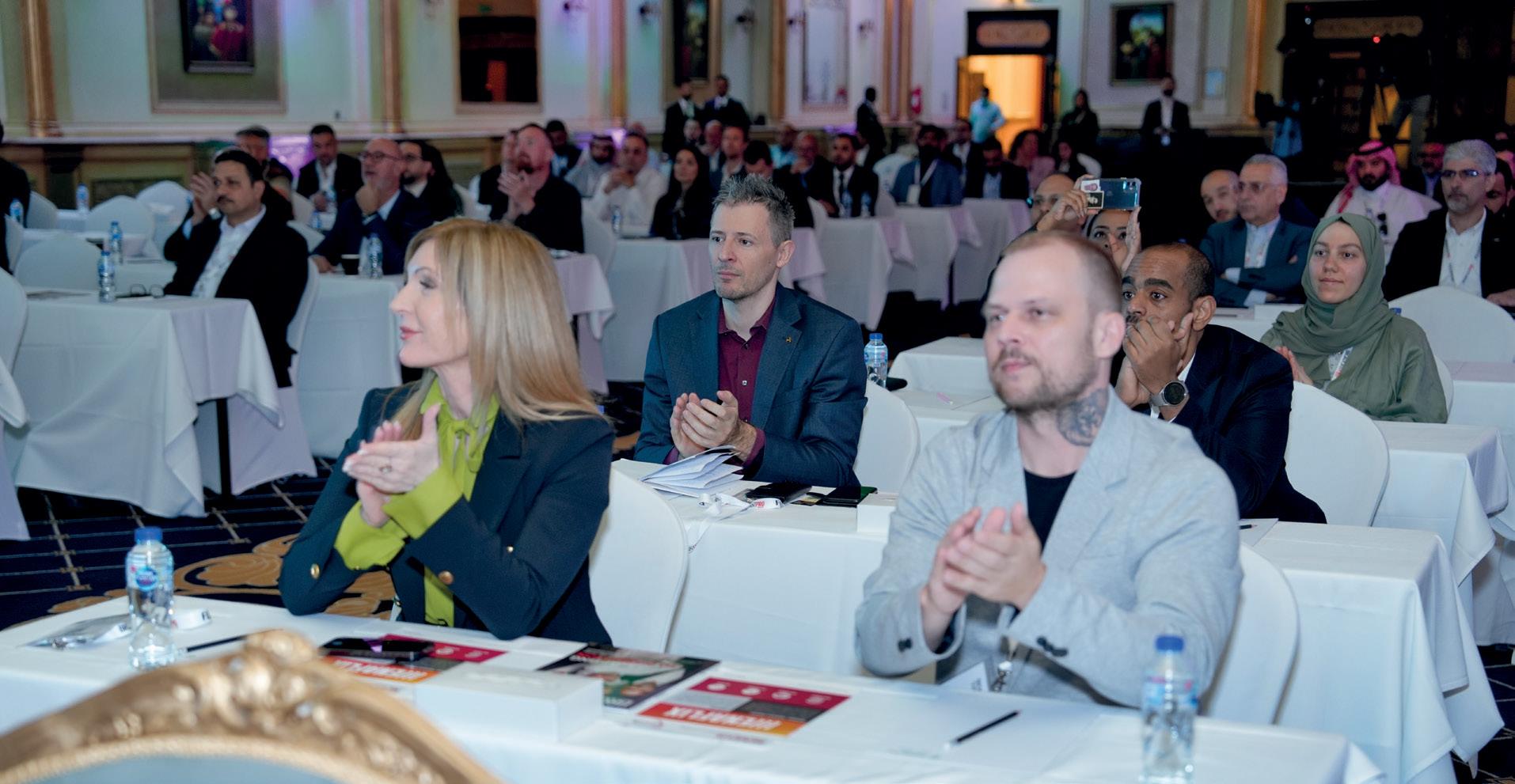

Navigating children’s entertainment today means embracing rapid evolution driven by technology and viewer expectations
In the ever-changing landscape of children’s entertainment, the days of passive viewing, where audiences were merely observers of unfolding storylines, are over. The model has evolved with viewers actively participating in the storytelling process and becoming integral parts of the journey rather than distant observers.
Exploring the potential of technological innovation
The digital age has opened doors to immersive experiences, interactive storytelling and personalised content delivery. From augmented reality (AR)to interactive apps, creators have myriad tools at their disposal to engage young audiences in innovative ways. AR, for example, helps children interact with characters and stories in their own environment. Interactive apps enhance this experience, offering myriad educational and entertaining content tailored to individual preferences and developmental stages. By leveraging data analytics and machine learning algorithms, content creators can curate experiences that are both age-appropriate and align with children’s interests.
The power of storytelling: Balancing entertainment and learning
While entertainment remains at the heart of children’s film and
TV experiences, there is a growing emphasis on blending entertainment with education. This presents both an opportunity and a challenge for content creators, as they strive to strike a balance between engaging narratives and valuable learning experiences.
Furthermore, collaboration across sectors including education, technology and entertainment paves the way for holistic content experiences. By leveraging expertise from diverse fields, creators can create content that not only entertains but also enriches and empowers young viewers, fostering creativity, curiosity and positive values.
Many platforms prioritise kids’ shows that blend action-packed content with lessons on teamwork and problemsolving. By incorporating these actions into their content, these shows subtly integrate educational themes into engaging storylines, offering young viewers practical insights into daily activities. This showcases the ability of content creators to skillfully combine entertainment with valuable learning opportunities, captivating children with positive messages and essential skills.
As we navigate the landscape of children’s targeted content, regulatory and ethical considerations play a crucial role. From content ratings to advertising guidelines,
there are various frameworks that shape the production and distribution of content for young audiences. Adhering to these standards while maintaining creative freedom requires a delicate balance, ensuring that content is both entertaining and responsible. Additionally, data privacy and online safety are paramount in digital experiences. With children increasingly engaging with content on digital platforms, safeguarding their well-being and privacy is a top priority. Creators and platforms must implement robust measures to protect young viewers and provide a safe and enriching environment for their entertainment experiences.
Navigating children’s entertainment today means embracing rapid evolution driven by technology and viewer expectations. Balancing creativity with ethics and safety is crucial. This convergence of entertainment and education empowers creators to engage young minds meaningfully, ensuring enriching experiences that inspire creativity and positive values. As this dynamic journey unfolds, children’s entertainment holds limitless potential to captivate and educate globally.
MONIKA OOMEN IS VP BRAND, COMMUNICATIONS AND DIGITAL CONTENT STRATEGY, KIDS EMEA AT WARNER BROS DISCOVERY


